
Most politically entrenched states in America—and how that could impact the election
Most politically entrenched states in America—and how that could impact the election
With the Nov. 3 presidential election now just days away, tensions are high. With battle lines clearly drawn, the only thing that both sides can seem to agree on is that more drama is likely to follow the election no matter which way the votes go—and millions of voters have already locked in their choices as record early voting turnout sweeps the nation.
Although the whole country is polarized, political partisanship is more entrenched in some states than in others.
Using historical and current state data from Gallup, Ballotpedia, the Cook Political Report, 270toWin, and the National Conference of State Legislatures, Stacker ranked the states by how politically entrenched—or how partisan—they are.
We first looked at how often a state voted for either the Democratic or the Republican party in the presidential election since 1964, the year the two parties realigned to form the parties they still are today. The states that voted for the same party the most, out of 14 elections, are ranked higher on the list, while those that have voted equally for both parties are ranked lower.
To break ties, Stacker looked at the Cook Partisan Voter Index, which measures how a state voted in the past two presidential elections compared to the national average of both years.
According to Cook, the Democratic presidential candidates won an average of about 51.5% of the vote between 2012 and 2016, and the Republican candidates won 48.5% of the vote. In the data, a Partisan Voter Index—a PVI score—of D +2, for example, means that the state performed roughly 2 points more Democratic in 2012 and 2016 than the nation did, and a score of R +3 means that the state performed more Republican than the national average of those two years. States that performed less than 0.5 points of the national average are considered "even."
Finally, Stacker listed the political affiliation of state residents, according to Gallup, and each state's current governor, U.S. senators, and state legislature. These statistics are not available for Washington D.C., as it does not have representatives in Congress or the state legislature. Additionally, the party affiliation for Nebraska is not included, as it has a nonpartisan, unicameral state legislature that is not tied to a specific party or ideology.
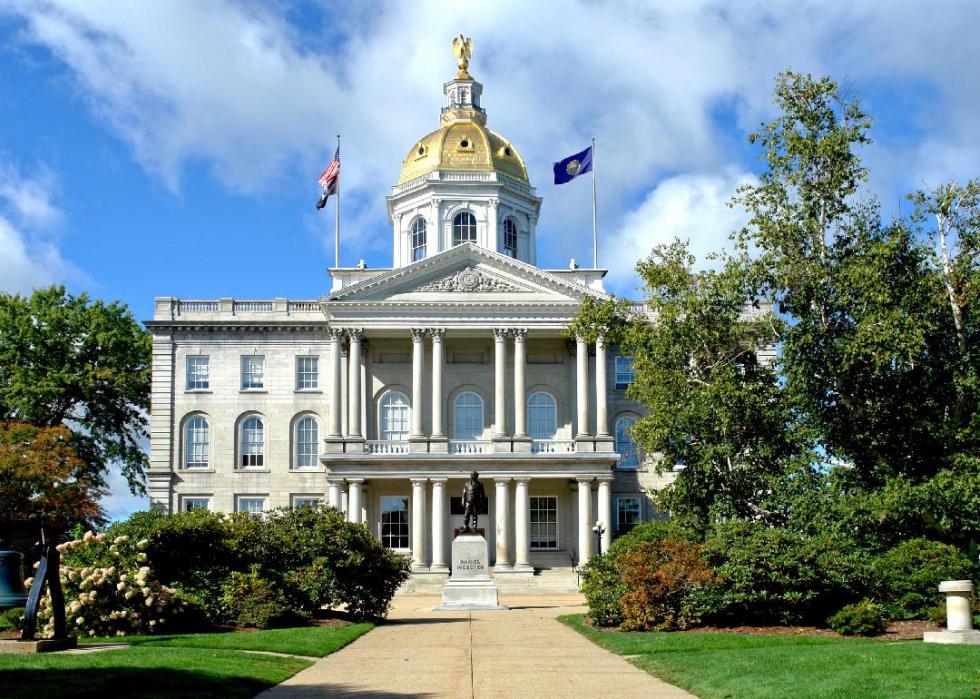
#51. New Hampshire
- Presidential election outcome between 1964-2016: voted 7 times Democratic (50%), 7 times Republican (50%)
- Cook Partisan Voter Index: even
--- 2016 state popular vote: 46.8% Hillary Clinton, 46.5% Donald Trump
--- 2012 state popular vote: 52% Barack Obama, 46.4% Mitt Romney
- Resident political affiliation: strong Democratic (48% Democrat or lean Democratic, 36% Republican or lean Republican)
- Governor political affiliation: Republican
- Senator political affiliation: 2 Democratic, 0 Republican
- Party in control of state legislature: Democratic
--- State senate: 14 Democratic (58.3%), 10 Republican (41.7%)
--- State house: 231 Democratic (57.8%), 158 Republican (39.5%)
Despite voting with the Democratic candidate in six of the past seven elections—most recently by a razor-thin margin—New Hampshire is a perennial swing state known for its fiercely independent electorate. Its four electoral votes are not a particularly juicy conquest, but New Hampshire is a bellwether state and a huge symbolic prize. The first state to hold a true primary vote after the Iowa caucuses, New Hampshire’s voters fire the starting gun for the political season.
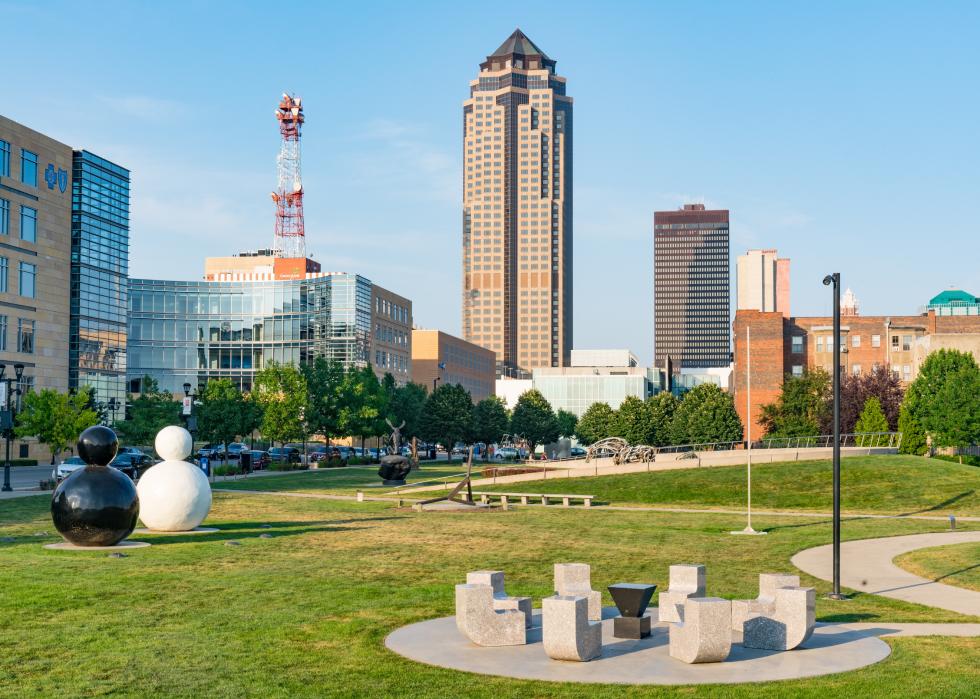
#50. Iowa
- Presidential election outcome between 1964-2016: voted 7 times Democratic (50%), 7 times Republican (50%)
- Cook Partisan Voter Index: R +3
--- 2016 state popular vote: 41.7% Hillary Clinton, 51.1% Donald Trump
--- 2012 state popular vote: 52% Barack Obama, 46.2% Mitt Romney
- Resident political affiliation: competitive (42% Democrat or lean Democratic, 42% Republican or lean Republican)
- Governor political affiliation: Republican
- Senator political affiliation: 0 Democratic, 2 Republican
- Party in control of state legislature: Republican
--- State senate: 18 Democratic (36%), 32 Republican (64%)
--- State house: 47 Democratic (47%), 53 Republican (53%)
The quaint and sometimes clumsy Iowa caucuses are one of the most peculiar and closely watched parts of the American electoral process, but Iowa is taking center stage in 2020 for different reasons. President Donald Trump won the state handily in 2016, beating Hillary Clinton by nearly 10 percentage points, yet Democratic challenger Joe Biden has now evaporated that lead and even pulled ahead in polling, according to FiveThirtyEight. To add to the drama, Republican Sen. Joni Ernst is fighting for her political life—in what was supposed to be a safe seat occupied by a rising GOP star—in a race that could determine whether her party retains control of the Senate.
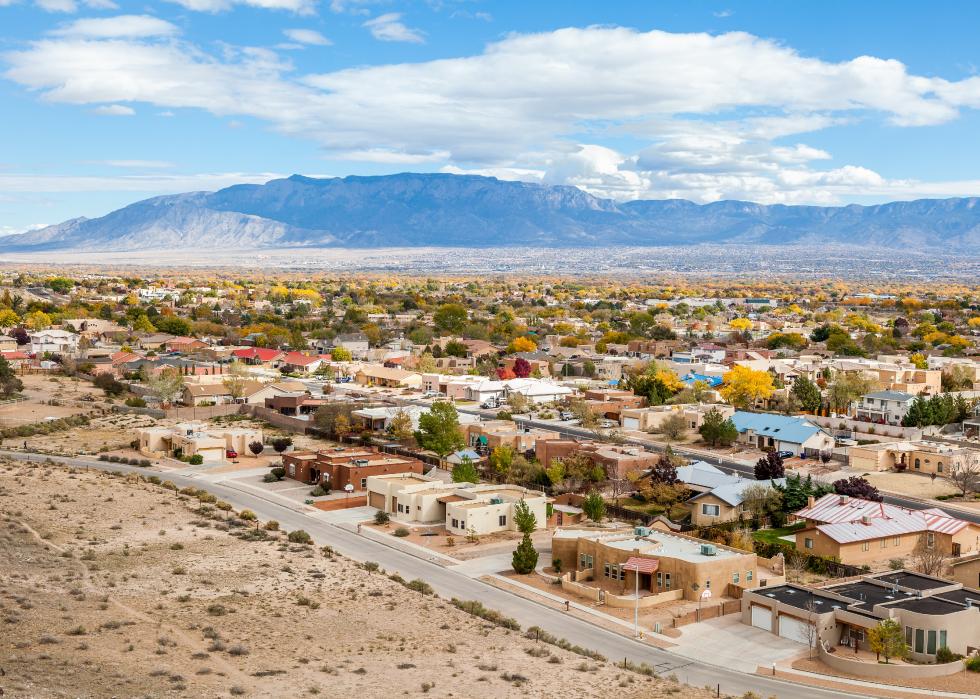
#49. New Mexico
- Presidential election outcome between 1964-2016: voted 7 times Democratic (50%), 7 times Republican (50%)
- Cook Partisan Voter Index: D +3
--- 2016 state popular vote: 48.3% Hillary Clinton, 40% Donald Trump
--- 2012 state popular vote: 53% Barack Obama, 42.8% Mitt Romney
- Resident political affiliation: strong Democratic (48% Democrat or lean Democratic, 38% Republican or lean Republican)
- Governor political affiliation: Democratic
- Senator political affiliation: 2 Democratic, 0 Republican
- Party in control of state legislature: Democratic
--- State senate: 26 Democratic (61.9%), 16 Republican (38.1%)
--- State house: 45 Democratic (64.3%), 24 Republican (34.3%)
Record turnout is all but guaranteed this year in New Mexico, where 37% of the state’s 1.33 million registered voters had cast their ballots the week before the election. Just as in much of the country, Democrats are dramatically outpacing Republicans there in early and absentee voting, but hundreds of thousands more voters are expected to add to the tally on Election Day.
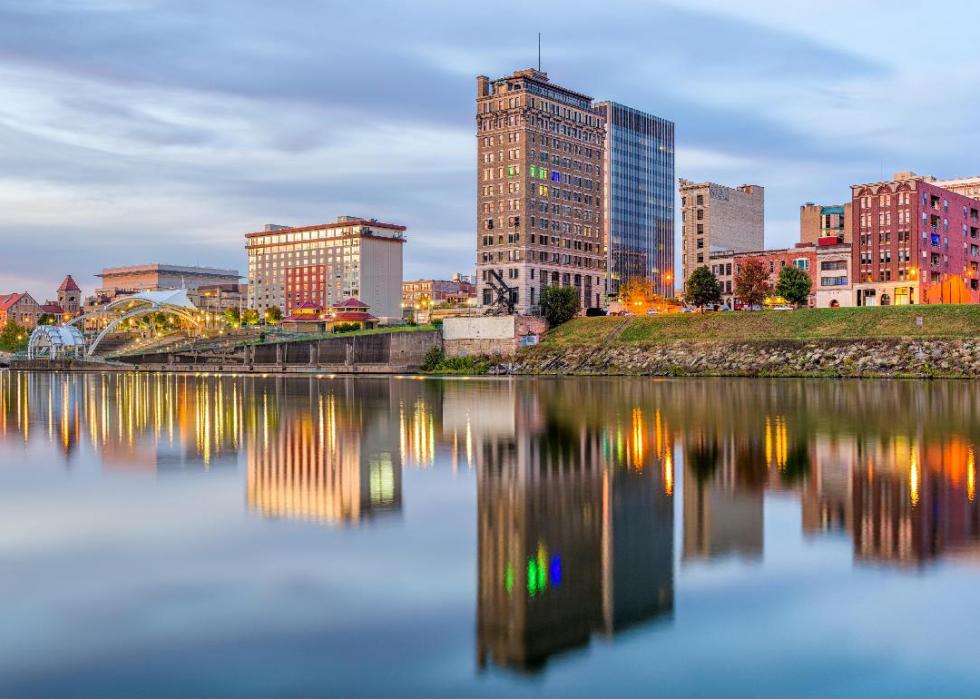
#48. West Virginia
- Presidential election outcome between 1964-2016: voted 7 times Democratic (50%), 7 times Republican (50%)
- Cook Partisan Voter Index: R +19
--- 2016 state popular vote: 26.5% Hillary Clinton, 68.6% Donald Trump
--- 2012 state popular vote: 35.5% Barack Obama, 62.3% Mitt Romney
- Resident political affiliation: strong Republican (37% Democrat or lean Democratic, 49% Republican or lean Republican)
- Governor political affiliation: Republican
- Senator political affiliation: 1 Democratic, 0 Republican
- Party in control of state legislature: Republican
--- State senate: 14 Democratic (41.2%), 20 Republican (58.8%)
--- State house: 41 Democratic (41%), 58 Republican (58%)
Reliably red West Virginia delivered Donald Trump a resounding victory in 2016, but the story dominating headlines in the state this cycle is not partisan divide, but intense interest in early voting. West Virginians flocked to the polls early in droves, and by the time the election was two weeks away, three out of four people who requested an absentee ballot had returned one, and more than 200,000 residents had already voted.
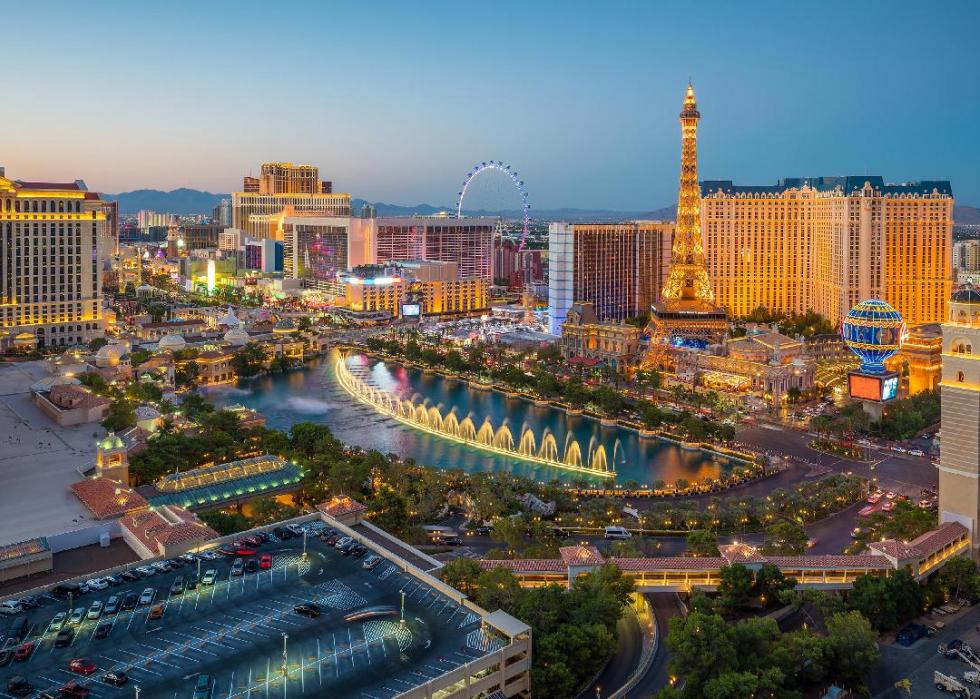
#47. Nevada
- Presidential election outcome between 1964-2016: voted 6 times Democratic (42.9%), 8 times Republican (57.1%)
- Cook Partisan Voter Index: D +1
--- 2016 state popular vote: 47.9% Hillary Clinton, 45.5% Donald Trump
--- 2012 state popular vote: 52.4% Barack Obama, 45.7% Mitt Romney
- Resident political affiliation: lean Democratic (45% Democrat or lean Democratic, 38% Republican or lean Republican)
- Governor political affiliation: Democratic
- Senator political affiliation: 2 Democratic, 0 Republican
- Party in control of state legislature: Democratic
--- State senate: 13 Democratic (61.9%), 8 Republican (38.1%)
--- State house: 29 Democratic (69%), 13 Republican (31%)
From the beginning, President Trump has insisted without substantiation that mail-in voting will be rigged or otherwise fraudulent. Evidence shows virtually no fraud within mail-in voting. In blue-leaning Nevada, one of the only battleground states in the West, the Trump campaign filed a lawsuit to block early vote counting in the state.
You may also like: 'I have a dream' and the rest of the greatest speeches of the 20th century
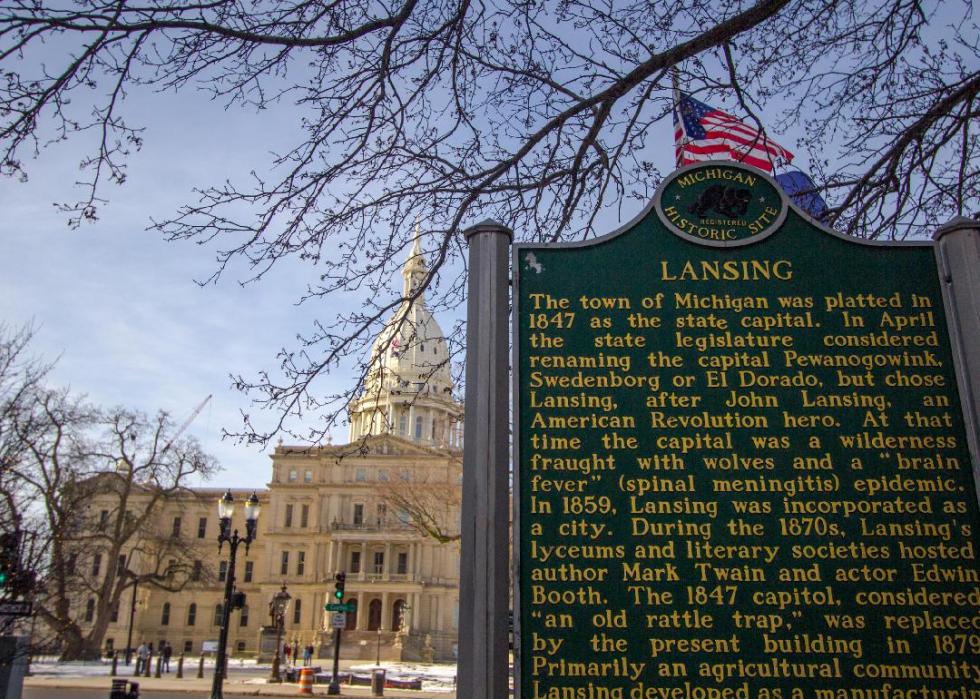
#46. Michigan
- Presidential election outcome between 1964-2016: voted 8 times Democratic (57.1%), 6 times Republican (42.9%)
- Cook Partisan Voter Index: D +1
--- 2016 state popular vote: 47.3% Hillary Clinton, 47.5% Donald Trump
--- 2012 state popular vote: 54.2% Barack Obama, 44.7% Mitt Romney
- Resident political affiliation: lean Democratic (45% Democrat or lean Democratic, 39% Republican or lean Republican)
- Governor political affiliation: Democratic
- Senator political affiliation: 2 Democratic, 0 Republican
- Party in control of state legislature: Republican
--- State senate: 16 Democratic (42.1%), 22 Republican (57.9%)
--- State house: 51 Democratic (46.4%), 58 Republican (52.7%)
Few states matter more than Michigan, a big brick in the Democrats’ so-called “blue wall” that Donald Trump dismantled en route to victory in 2016. The president won Michigan by the slimmest of margins four years ago and without it, the path to victory becomes much more daunting for both candidates in 2020.
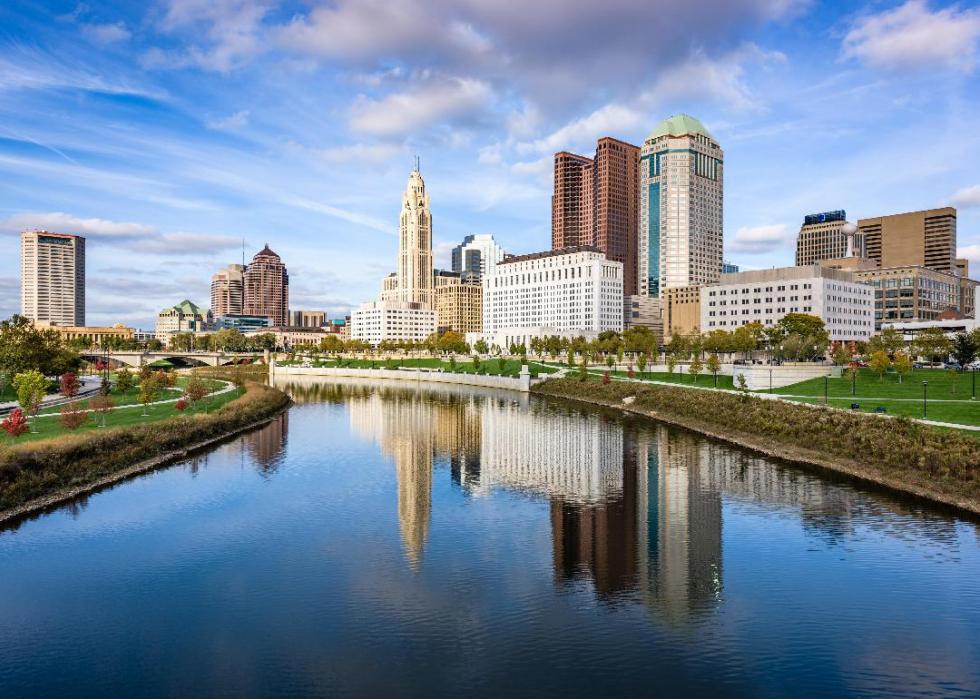
#45. Ohio
- Presidential election outcome between 1964-2016: voted 6 times Democratic (42.9%), 8 times Republican (57.1%)
- Cook Partisan Voter Index: R +3
--- 2016 state popular vote: 43.6% Hillary Clinton, 51.7% Donald Trump
--- 2012 state popular vote: 50.7% Barack Obama, 47.7% Mitt Romney
- Resident political affiliation: competitive (41% Democrat or lean Democratic, 45% Republican or lean Republican)
- Governor political affiliation: Republican
- Senator political affiliation: 1 Democratic, 1 Republican
- Party in control of state legislature: Republican
--- State senate: 9 Democratic (27.3%), 24 Republican (72.7%)
--- State house: 38 Democratic (38.4%), 61 Republican (61.6%)
As in so many crucial swing states, unprecedented numbers of Ohioans locked in their votes well before Election Day. More than 1.11 million Ohio voters cast their ballots in a little more than two weeks in October and more than 2.7 million absentee ballots were returned when the election was still more than a week away. Those numbers dwarf the returns tallied during the same time period in 2016.

#44. New Jersey
- Presidential election outcome between 1964-2016: voted 8 times Democratic (57.1%), 6 times Republican (42.9%)
- Cook Partisan Voter Index: D +7
--- 2016 state popular vote: 55.5% Hillary Clinton, 41.4% Donald Trump
--- 2012 state popular vote: 58.4% Barack Obama, 40.6% Mitt Romney
- Resident political affiliation: strong Democratic (50% Democrat or lean Democratic, 35% Republican or lean Republican)
- Governor political affiliation: Democratic
- Senator political affiliation: 2 Democratic, 0 Republican
- Party in control of state legislature: Democratic
--- State senate: 25 Democratic (62.5%), 15 Republican (37.5%)
--- State house: 52 Democratic (65%), 28 Republican (35%)
Three weeks before Election Day, The New York Times reported that Democrats were far outpacing Republicans in terms of early voting, even in the blue state’s most conservative strongholds. There, as in so much of the country, voters are casting ballots early in historic numbers that overwhelmingly favor Democrats.
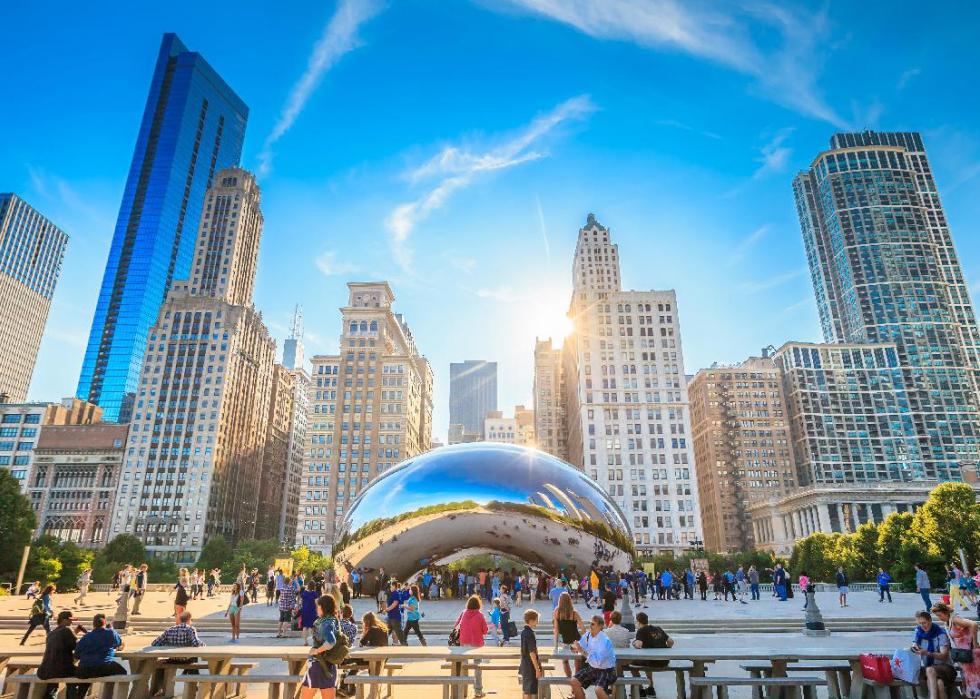
#43. Illinois
- Presidential election outcome between 1964-2016: voted 8 times Democratic (57.1%), 6 times Republican (42.9%)
- Cook Partisan Voter Index: D +7
--- 2016 state popular vote: 55.8% Hillary Clinton, 38.8% Donald Trump
--- 2012 state popular vote: 57.6% Barack Obama, 40.7% Mitt Romney
- Resident political affiliation: strong Democratic (50% Democrat or lean Democratic, 34% Republican or lean Republican)
- Governor political affiliation: Democratic
- Senator political affiliation: 2 Democratic, 0 Republican
- Party in control of state legislature: Democratic
--- State senate: 40 Democratic (67.8%), 19 Republican (32.2%)
--- State house: 73 Democratic (61.9%), 44 Republican (37.3%)
Illinois has been reliably blue since it voted for its last Republican presidential candidate, George H.W. Bush, in 1988—Chicago is a favorite target for conservatives who consider the city a portrait of the failures of Democratic leadership. Following a national trend, early voting in Illinois is shattering records, with 1.8 million votes cast statewide when there was still more than a week to go before Election Day.

#42. California
- Presidential election outcome between 1964-2016: voted 8 times Democratic (57.1%), 6 times Republican (42.9%)
- Cook Partisan Voter Index: D +12
--- 2016 state popular vote: 61.7% Hillary Clinton, 31.6% Donald Trump
--- 2012 state popular vote: 60.2% Barack Obama, 37.1% Mitt Romney
- Resident political affiliation: strong Democratic (51% Democrat or lean Democratic, 31% Republican or lean Republican)
- Governor political affiliation: Democratic
- Senator political affiliation: 2 Democratic, 0 Republican
- Party in control of state legislature: Democratic
--- State senate: 29 Democratic (72.5%), 11 Republican (27.5%)
--- State house: 61 Democratic (76.3%), 17 Republican (21.3%)
If political parties were species, the GOP in California would be listed as endangered for extinction—as of 2019, the Democrats had 45% of the voters in California, according to the Record Searchlight. The GOP, commanding less than 25% of the vote, now comes in third behind "no party preference" and a Republican hasn't held statewide office there since Arnold Schwarzenegger was re-elected as governor in 2006. California's 55 electoral votes—the biggest prize of any state by far—is all but guaranteed to the Democrats.
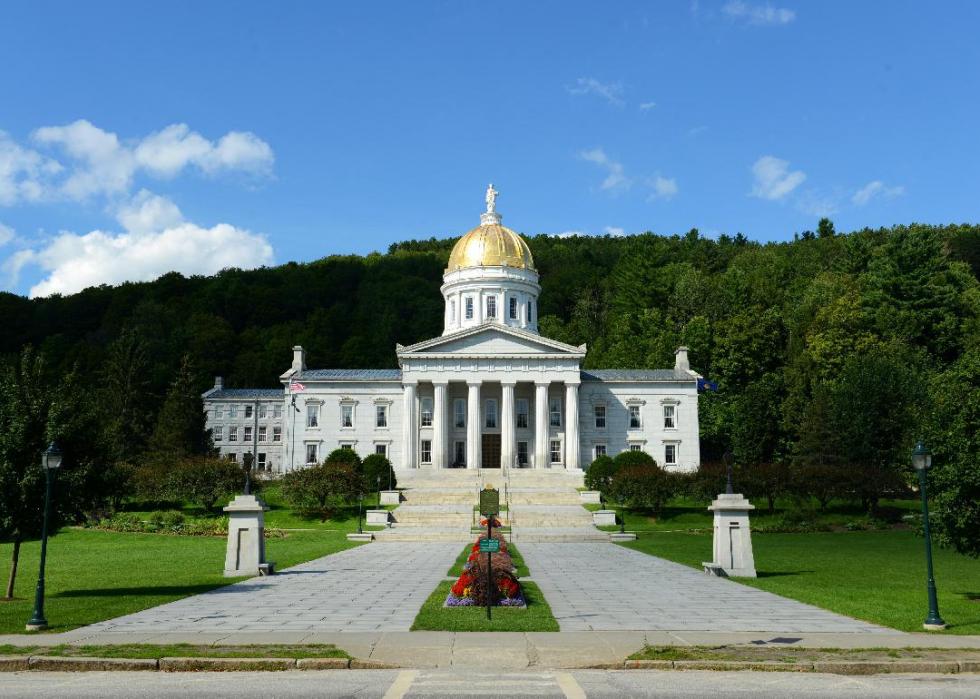
#41. Vermont
- Presidential election outcome between 1964-2016: voted 8 times Democratic (57.1%), 6 times Republican (42.9%)
- Cook Partisan Voter Index: D +15
--- 2016 state popular vote: 56.7% Hillary Clinton, 30.3% Donald Trump
--- 2012 state popular vote: 66.6% Barack Obama, 31% Mitt Romney
- Resident political affiliation: strong Democratic (55% Democrat or lean Democratic, 30% Republican or lean Republican)
- Governor political affiliation: Republican
- Senator political affiliation: 1 Democratic, 0 Republican
- Party in control of state legislature: Democratic
--- State senate: 22 Democratic (73.3%), 6 Republican (20%)
--- State house: 150 Democratic (7500%), 94 Republican (4700%)
Progressive Vermont, home to Sen. Bernie Sanders, is a relatively recent convert to the Democratic Party. The state voted Republican in every election cycle but one from 1856-1988. This year, Vermont voters set an early voting record for the state when the election was still three weeks away.
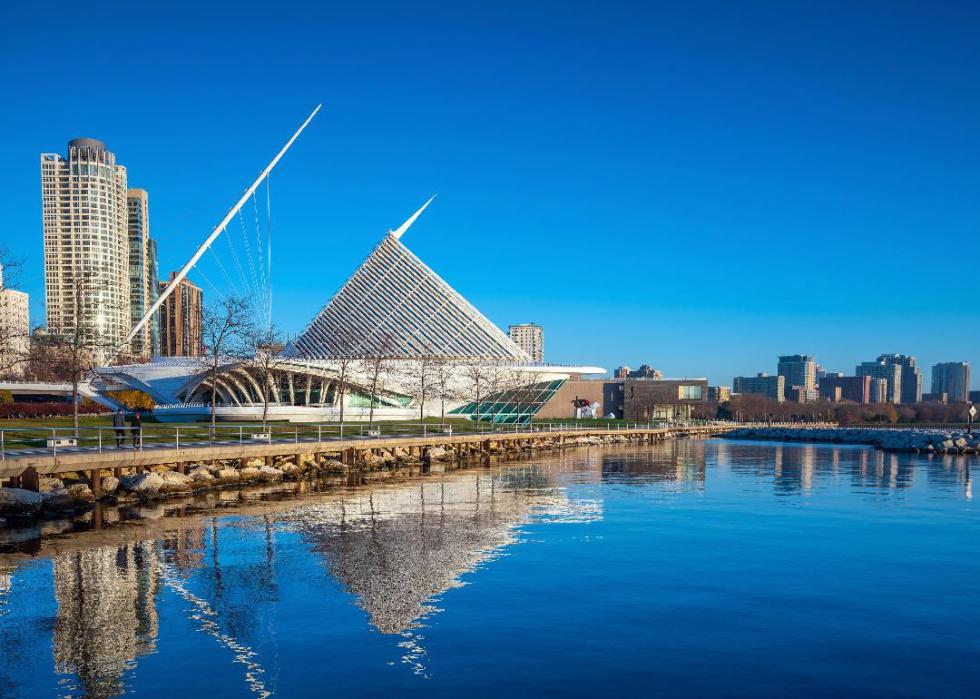
#40. Wisconsin
- Presidential election outcome between 1964-2016: voted 9 times Democratic (64.3%), 5 times Republican (35.7%)
- Cook Partisan Voter Index: even
--- 2016 state popular vote: 46.5% Hillary Clinton, 47.2% Donald Trump
--- 2012 state popular vote: 52.8% Barack Obama, 45.9% Mitt Romney
- Resident political affiliation: competitive (43% Democrat or lean Democratic, 43% Republican or lean Republican)
- Governor political affiliation: Democratic
- Senator political affiliation: 1 Democratic, 0 Republican
- Party in control of state legislature: Republican
--- State senate: 13 Democratic (39.4%), 18 Republican (54.5%)
--- State house: 35 Democratic (35.4%), 63 Republican (63.6%)
Along with Pennsylvania, Michigan, and Florida, Wisconsin is one of the most important swing states for both parties, and as a perennial battleground state, Wisconsin voters have grown accustomed to being fought over in campaigns. Four years ago, by the slimmest of margins, Trump managed to wrestle Wisconsin away from the Democrats for the first time since Ronald Regan won the state in 1984. The electorate there is teetering on the fence once again this year, but with early votes piling up, Biden is amassing a measurable lead in the home stretch, according to the University of Wisconsin-Madison.

#39. Pennsylvania
- Presidential election outcome between 1964-2016: voted 9 times Democratic (64.3%), 5 times Republican (35.7%)
- Cook Partisan Voter Index: even
--- 2016 state popular vote: 47.9% Hillary Clinton, 48.6% Donald Trump
--- 2012 state popular vote: 52% Barack Obama, 46.6% Mitt Romney
- Resident political affiliation: lean Democratic (46% Democrat or lean Democratic, 40% Republican or lean Republican)
- Governor political affiliation: Democratic
- Senator political affiliation: 1 Democratic, 1 Republican
- Party in control of state legislature: Republican
--- State senate: 21 Democratic (42%), 28 Republican (56%)
--- State house: 203 Democratic (20300%), 93 Republican (9300%)
Although its Electoral College clout continues to dwindle, the 20 votes Pennsylvania brings to the table still hold the keys to the kingdom for both the Democrats and their GOP rivals. In 2020, all the most likely routes to victory for both candidates lead through Pennsylvania. Trump won the state four years ago by the narrowest of margins—a crushing defeat still fresh in the minds of Democrats—which was the final brick in what had been the party’s blue wall.

#38. Colorado
- Presidential election outcome between 1964-2016: voted 5 times Democratic (35.7%), 9 times Republican (64.3%)
- Cook Partisan Voter Index: D +1
--- 2016 state popular vote: 48.2% Hillary Clinton, 43.3% Donald Trump
--- 2012 state popular vote: 51.5% Barack Obama, 46.1% Mitt Romney
- Resident political affiliation: lean Democratic (47% Democrat or lean Democratic, 40% Republican or lean Republican)
- Governor political affiliation: Democratic
- Senator political affiliation: 1 Democratic, 1 Republican
- Party in control of state legislature: Democratic
--- State senate: 19 Democratic (54.3%), 16 Republican (45.7%)
--- State house: 41 Democratic (63.1%), 24 Republican (36.9%)
In the first week that polls were open, Coloradans tallied 24 times the number of votes they did during the same period in 2016, breaking early voting records across the state. Not only is Colorado one of the only true battleground states in the West, but it’s at the center of a critical Senate race that could determine which party controls the upper chamber in 2021. Democrat John Hickenlooper, a former governor, is under intense pressure to flip the seat currently held by GOP Rep. Cory Gardner, who came to office in 2014.
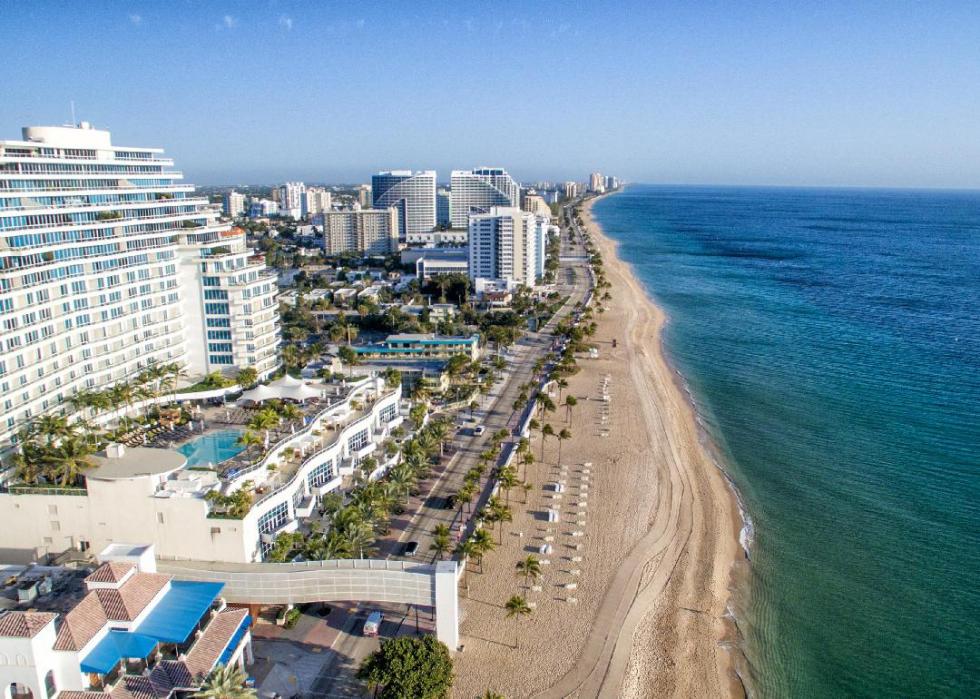
#37. Florida
- Presidential election outcome between 1964-2016: voted 5 times Democratic (35.7%), 9 times Republican (64.3%)
- Cook Partisan Voter Index: R +2
--- 2016 state popular vote: 47.8% Hillary Clinton, 49% Donald Trump
--- 2012 state popular vote: 50% Barack Obama, 49.1% Mitt Romney
- Resident political affiliation: competitive (42% Democrat or lean Democratic, 41% Republican or lean Republican)
- Governor political affiliation: Republican
- Senator political affiliation: 0 Democratic, 2 Republican
- Party in control of state legislature: Republican
--- State senate: 17 Democratic (42.5%), 23 Republican (57.5%)
--- State house: 46 Democratic (38.3%), 73 Republican (60.8%)
The new millennium started with historic election drama, chaos, and controversy in Florida, when terms like "hanging chad" first entered the American lexicon. In the ensuing two decades, the Sunshine State has served as the main front in the battle for the Electoral College. Six decades of explosive population growth has buoyed Florida's count to a rich 29 electoral votes, and widespread demographic changes keep the hard-to-predict state in flux and in play for both sides.
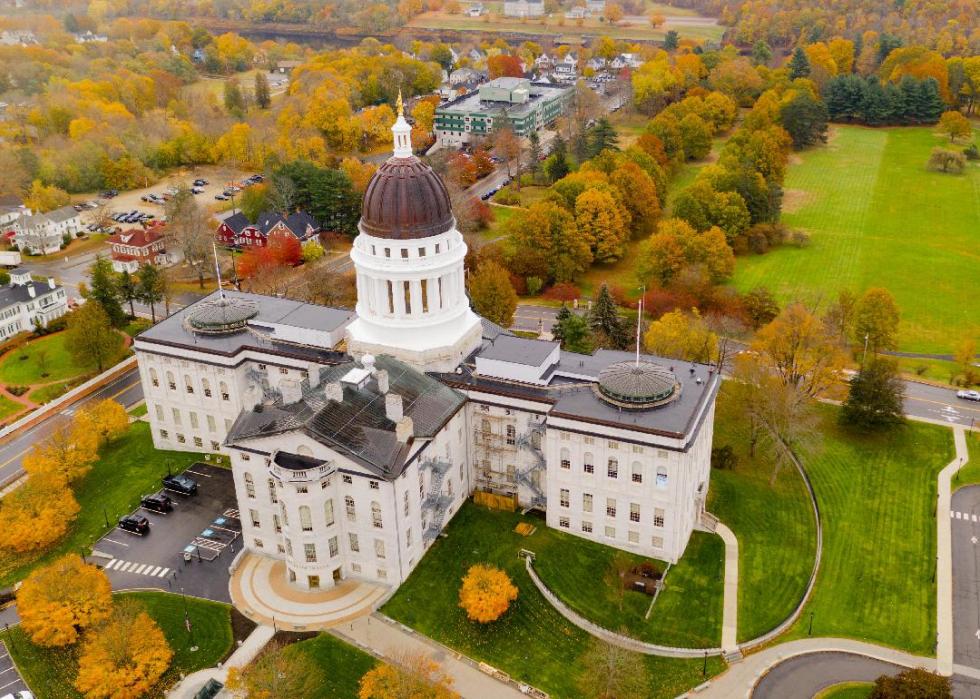
#36. Maine
- Presidential election outcome between 1964-2016: voted 9 times Democratic (64.3%), 5 times Republican (35.7%)
- Cook Partisan Voter Index: D +3
--- 2016 state popular vote: 47.8% Hillary Clinton, 44.9% Donald Trump
--- 2012 state popular vote: 56.3% Barack Obama, 41% Mitt Romney
- Resident political affiliation: strong Democratic (50% Democrat or lean Democratic, 37% Republican or lean Republican)
- Governor political affiliation: Democratic
- Senator political affiliation: 0 Democratic, 1 Republican
- Party in control of state legislature: Democratic
--- State senate: 21 Democratic (60%), 14 Republican (40%)
--- State house: 88 Democratic (58.3%), 57 Republican (37.7%)
Maine has been reliably blue for three decades, but in 2016, the New England state went purple. One of only two states with the ability to split its electoral votes—Nebraska is the other—Maine delivered three of its four votes to Hillary Clinton four years ago and one to President Trump. This year, however, all eyes are on the state’s big Senate race as longtime incumbent Susan Collins is in the fight of her career against Democratic challenger Sara Gideon.

#35. Oregon
- Presidential election outcome between 1964-2016: voted 9 times Democratic (64.3%), 5 times Republican (35.7%)
- Cook Partisan Voter Index: D +5
--- 2016 state popular vote: 50.1% Hillary Clinton, 39.1% Donald Trump
--- 2012 state popular vote: 54.2% Barack Obama, 42.2% Mitt Romney
- Resident political affiliation: lean Democratic (47% Democrat or lean Democratic, 38% Republican or lean Republican)
- Governor political affiliation: Democratic
- Senator political affiliation: 2 Democratic, 0 Republican
- Party in control of state legislature: Democratic
--- State senate: 18 Democratic (60%), 12 Republican (40%)
--- State house: 38 Democratic (63.3%), 22 Republican (36.7%)
The 2000 election was the last time the Democratic candidate received less than 50% of the vote in Oregon, which last voted Republican in 1984. By early October, more than one in three Oregonians had already voted, with Democrats far outpacing their GOP rivals in this corner of the solid-blue West Coast.

#34. Delaware
- Presidential election outcome between 1964-2016: voted 9 times Democratic (64.3%), 5 times Republican (35.7%)
- Cook Partisan Voter Index: D +6
--- 2016 state popular vote: 53.4% Hillary Clinton, 41.9% Donald Trump
--- 2012 state popular vote: 58.6% Barack Obama, 40% Mitt Romney
- Resident political affiliation: strong Democratic (48% Democrat or lean Democratic, 35% Republican or lean Republican)
- Governor political affiliation: Democratic
- Senator political affiliation: 2 Democratic, 0 Republican
- Party in control of state legislature: Democratic
--- State senate: 12 Democratic (57.1%), 9 Republican (42.9%)
--- State house: 26 Democratic (63.4%), 15 Republican (36.6%)
In 2016, Hillary Clinton creamed Donald Trump in Delaware, which has joined many of its Northeastern neighbors in voting Democratic in the past seven elections straight. Even Clinton’s wide victory wasn’t much to brag about on Joe Biden’s home-turf. Barack Obama took nearly 62% of the Delaware vote in 2008.
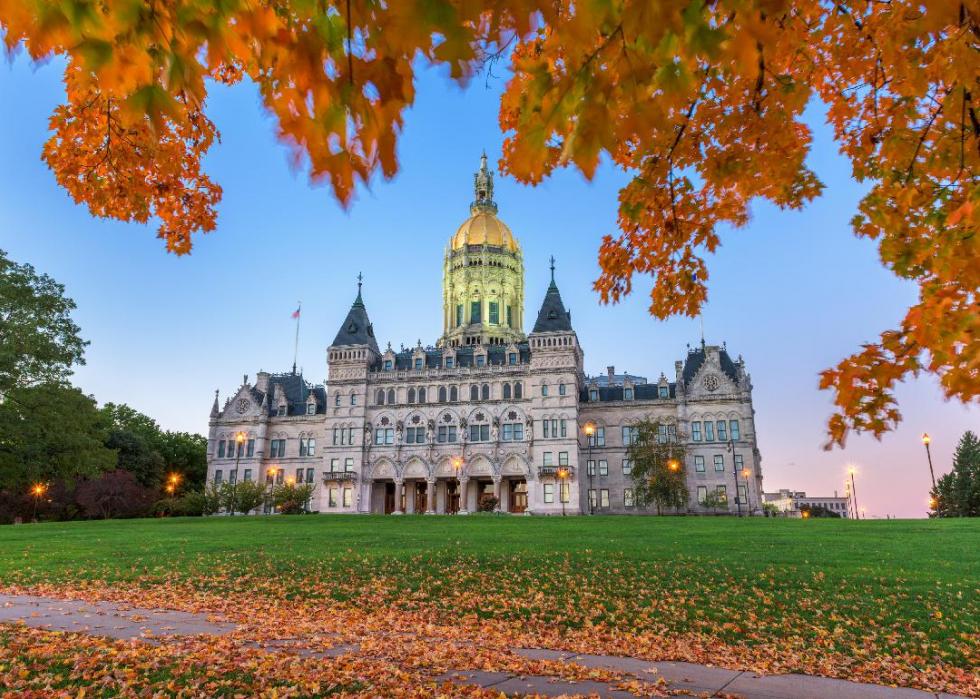
#33. Connecticut
- Presidential election outcome between 1964-2016: voted 9 times Democratic (64.3%), 5 times Republican (35.7%)
- Cook Partisan Voter Index: D +6
--- 2016 state popular vote: 54.6% Hillary Clinton, 40.9% Donald Trump
--- 2012 state popular vote: 58.1% Barack Obama, 40.8% Mitt Romney
- Resident political affiliation: strong Democratic (52% Democrat or lean Democratic, 33% Republican or lean Republican)
- Governor political affiliation: Democratic
- Senator political affiliation: 2 Democratic, 0 Republican
- Party in control of state legislature: Democratic
--- State senate: 22 Democratic (61.1%), 14 Republican (38.9%)
--- State house: 91 Democratic (60.3%), 60 Republican (39.7%)
Par for the course in its region of the country, Connecticut went blue in the past seven consecutive cycles straight. Like Delaware, it’s not a battleground state, and also like Delaware, Hillary Clinton crushed Donald Trump by double-digits there in 2016. Even that margin, however, was slim compared to 2008, when Barack Obama took more than 60% of the vote.
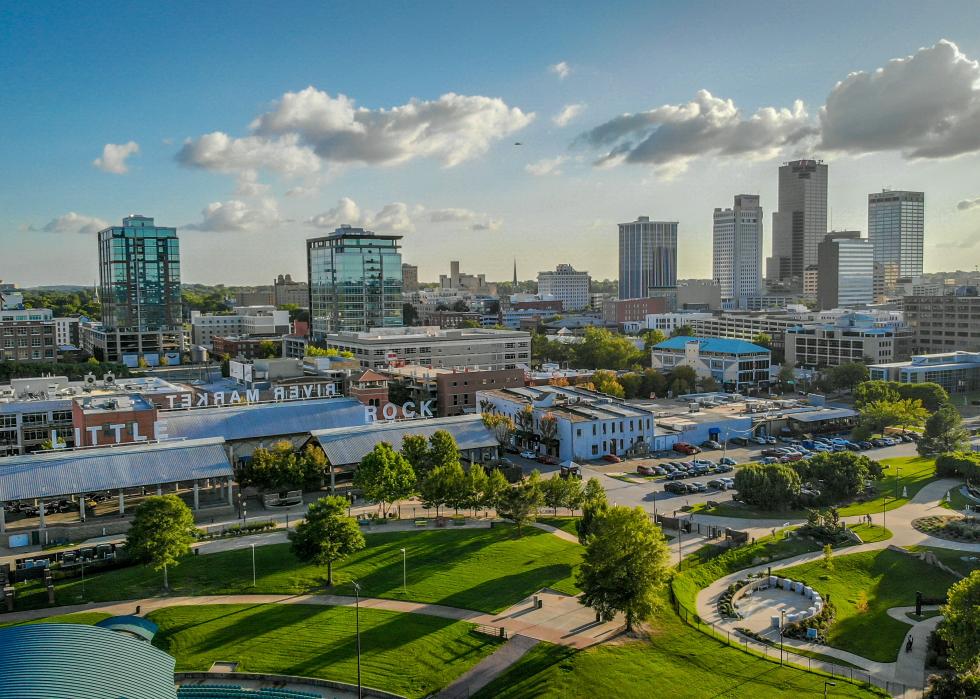
#32. Arkansas
- Presidential election outcome between 1964-2016: voted 4 times Democratic (28.6%), 9 times Republican (64.3%)
- Cook Partisan Voter Index: R +15
--- 2016 state popular vote: 33.7% Hillary Clinton, 60.6% Donald Trump
--- 2012 state popular vote: 36.9% Barack Obama, 60.6% Mitt Romney
- Resident political affiliation: strong Republican (35% Democrat or lean Democratic, 48% Republican or lean Republican)
- Governor political affiliation: Republican
- Senator political affiliation: 0 Democratic, 2 Republican
- Party in control of state legislature: Republican
--- State senate: 9 Democratic (25.7%), 26 Republican (74.3%)
--- State house: 23 Democratic (23%), 75 Republican (75%)
Arkansas has gone blue just three times since it voted for segregationist George Wallace in 1968—once for Southerner Jimmy Carter and twice for state native Bill Clinton. Like most of its neighbors in the South, Arkansas was reliably Democratic when Democrats were the party of segregation. It joined those neighbors in switching to the GOP when Texas Democrat Lyndon Johnson signed major civil rights legislation in the mid-1960s.

#31. Virginia
- Presidential election outcome between 1964-2016: voted 4 times Democratic (28.6%), 10 times Republican (71.4%)
- Cook Partisan Voter Index: D +1
--- 2016 state popular vote: 49.8% Hillary Clinton, 44.4% Donald Trump
--- 2012 state popular vote: 51.2% Barack Obama, 47.3% Mitt Romney
- Resident political affiliation: lean Democratic (46% Democrat or lean Democratic, 39% Republican or lean Republican)
- Governor political affiliation: Democratic
- Senator political affiliation: 2 Democratic, 0 Republican
- Party in control of state legislature: Democratic
--- State senate: 21 Democratic (52.5%), 19 Republican (47.5%)
--- State house: 55 Democratic (55%), 45 Republican (45%)
Virginia is proof that Democrats are capable of converting former Southern strongholds into reliably blue states. The former heart of the Confederacy, deep red Virginia flipped to the Democrats in the face of dramatic demographic changes characterized by suburbanization, the depopulation of rural areas, and, perhaps most importantly, increased diversity. It now has a Democratic governor, two Democratic senators, and voted blue in the past three presidential elections.

#30. Washington
- Presidential election outcome between 1964-2016: voted 10 times Democratic (71.4%), 4 times Republican (28.6%)
- Cook Partisan Voter Index: D +7
--- 2016 state popular vote: 51.8% Hillary Clinton, 36.3% Donald Trump
--- 2012 state popular vote: 56.2% Barack Obama, 41.3% Mitt Romney
- Resident political affiliation: strong Democratic (50% Democrat or lean Democratic, 35% Republican or lean Republican)
- Governor political affiliation: Democratic
- Senator political affiliation: 2 Democratic, 0 Republican
- Party in control of state legislature: Democratic
--- State senate: 29 Democratic (59.2%), 20 Republican (40.8%)
--- State house: 57 Democratic (58.2%), 41 Republican (41.8%)
Washington joins Oregon and California in the Democrats’ West Coast stronghold, which held up with little resistance in 2016 despite Trump’s smashing of the blue wall out east. Washington hasn’t voted Republican since 1984 and the Democratic candidate earned at least 50% of the vote in every presidential election of the 21st century.
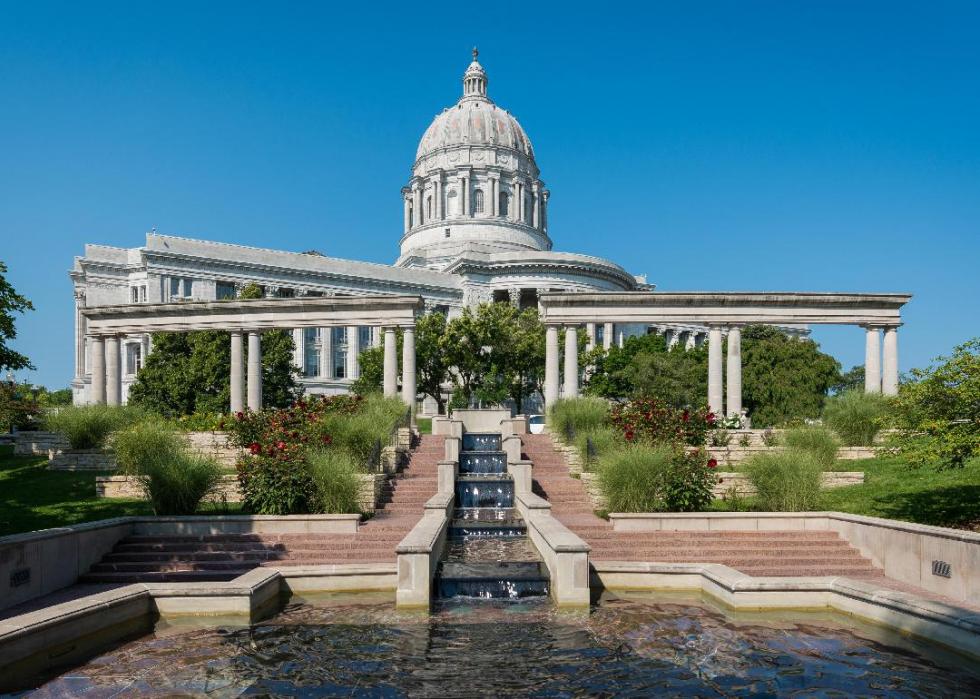
#29. Missouri
- Presidential election outcome between 1964-2016: voted 4 times Democratic (28.6%), 10 times Republican (71.4%)
- Cook Partisan Voter Index: R +9
--- 2016 state popular vote: 38.1% Hillary Clinton, 56.8% Donald Trump
--- 2012 state popular vote: 44.4% Barack Obama, 53.8% Mitt Romney
- Resident political affiliation: lean Republican (38% Democrat or lean Democratic, 47% Republican or lean Republican)
- Governor political affiliation: Republican
- Senator political affiliation: 0 Democratic, 2 Republican
- Party in control of state legislature: Republican
--- State senate: 8 Democratic (23.5%), 23 Republican (67.6%)
--- State house: 48 Democratic (29.4%), 113 Republican (69.3%)
With Democrats more likely to vote by mail, some red states have gone out of their way to make voting by mail as difficult as possible. In Missouri, for example, voters must request mail-in ballots in person or by mail, ballot signatures must be notarized, and completed ballots cannot be dropped off in person. These deliberate roadblocks have triggered several lawsuits across the state.
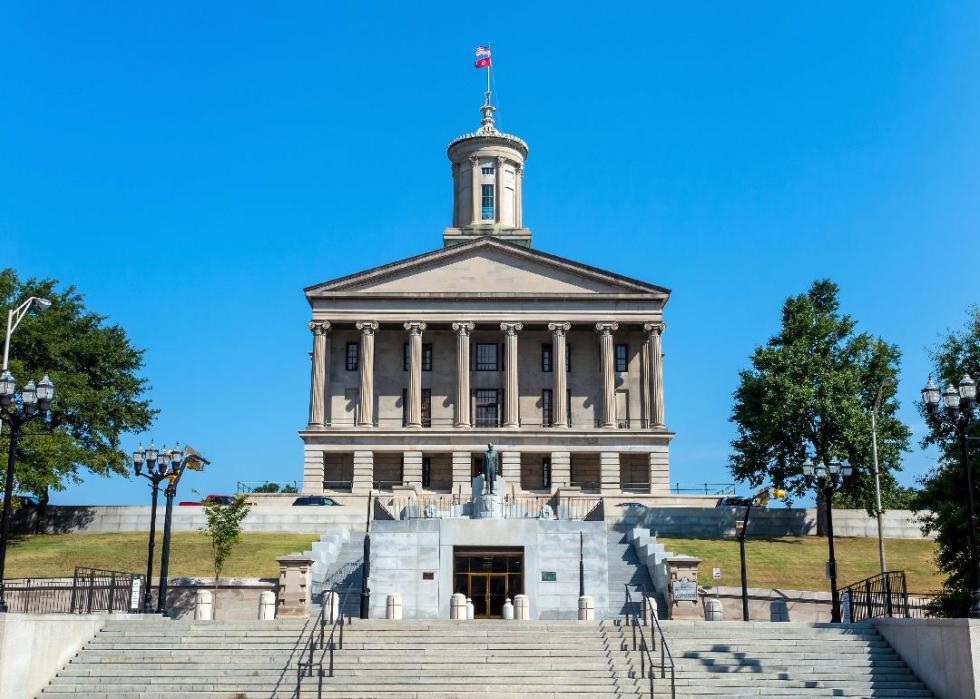
#28. Tennessee
- Presidential election outcome between 1964-2016: voted 4 times Democratic (28.6%), 10 times Republican (71.4%)
- Cook Partisan Voter Index: R +14
--- 2016 state popular vote: 34.7% Hillary Clinton, 60.7% Donald Trump
--- 2012 state popular vote: 39.1% Barack Obama, 59.5% Mitt Romney
- Resident political affiliation: strong Republican (35% Democrat or lean Democratic, 48% Republican or lean Republican)
- Governor political affiliation: Republican
- Senator political affiliation: 0 Democratic, 2 Republican
- Party in control of state legislature: Republican
--- State senate: 5 Democratic (15.2%), 28 Republican (84.8%)
--- State house: 26 Democratic (26.3%), 73 Republican (73.7%)
Many states have disenfranchised large portions of the population for generations by linking the right to vote with one’s status in the criminal justice system. Several states are reversing course and removing lifetime voting restrictions from convicted felons—but not Tennessee. In a state where 20% of African American adults can’t vote because of a felony conviction and no path to voting rights restoration exists, Tennessee recently won a legal ruling that upheld the state’s policy of forbidding ex-felons from voting even when they were convicted in another state.

#27. Kentucky
- Presidential election outcome between 1964-2016: voted 4 times Democratic (28.6%), 10 times Republican (71.4%)
- Cook Partisan Voter Index: R +15
--- 2016 state popular vote: 32.7% Hillary Clinton, 62.5% Donald Trump
--- 2012 state popular vote: 37.8% Barack Obama, 60.5% Mitt Romney
- Resident political affiliation: competitive (42% Democrat or lean Democratic, 45% Republican or lean Republican)
- Governor political affiliation: Democratic
- Senator political affiliation: 0 Democratic, 2 Republican
- Party in control of state legislature: Republican
--- State senate: 10 Democratic (26.3%), 28 Republican (73.7%)
--- State house: 38 Democratic (38%), 62 Republican (62%)
Judging by the most recent polls, Kentucky Sen. Mitch McConnell will likely fend off Democrat Amy McGrath's challenge and win his bid for a seventh six-year term in the Senate. The fact that it's even close, however, has put on display just how fragile the GOP's hold on the upper chamber has become. Senate Majority Leader McConnell is not only an entrenched incumbent, but one of the most familiar and powerful players in the whole of American politics.

#26. Georgia
- Presidential election outcome between 1964-2016: voted 3 times Democratic (21.4%), 10 times Republican (71.4%)
- Cook Partisan Voter Index: R +5
--- 2016 state popular vote: 45.9% Hillary Clinton, 51% Donald Trump
--- 2012 state popular vote: 45.5% Barack Obama, 53.3% Mitt Romney
- Resident political affiliation: competitive (43% Democrat or lean Democratic, 42% Republican or lean Republican)
- Governor political affiliation: Republican
- Senator political affiliation: 0 Democratic, 2 Republican
- Party in control of state legislature: Republican
--- State senate: 21 Democratic (37.5%), 35 Republican (62.5%)
--- State house: 75 Democratic (41.7%), 105 Republican (58.3%)
Until recently, flipping the Deep South state of Georgia would have been a pipe dream for the Democrats, but Joe Biden is competing well in the rapidly changing state. Two years ago, the Democrats came tantalizingly close to winning the Statehouse when Stacey Abrams lost her bid to become governor by less than 55,000 votes. According to Politico, African American voters are especially energized this year after the chaotic 2018 midterm election forced countless, mostly minority, Georgians to wait in line for hours to vote.

#25. Louisiana
- Presidential election outcome between 1964-2016: voted 3 times Democratic (21.4%), 10 times Republican (71.4%)
- Cook Partisan Voter Index: R +11
--- 2016 state popular vote: 38.4% Hillary Clinton, 58.1% Donald Trump
--- 2012 state popular vote: 40.6% Barack Obama, 57.8% Mitt Romney
- Resident political affiliation: lean Republican (37% Democrat or lean Democratic, 45% Republican or lean Republican)
- Governor political affiliation: Democratic
- Senator political affiliation: 0 Democratic, 2 Republican
- Party in control of state legislature: Republican
--- State senate: 12 Democratic (30.8%), 27 Republican (69.2%)
--- State house: 35 Democratic (33.3%), 68 Republican (64.8%)
Louisiana voted for George Wallace in 1968 and since then voted Republican in every election with the exception of three times when Southern governors were on the ballot—Jimmy Carter once and Bill Clinton twice. Since then, the GOP candidate hasn’t earned less than 52% of the vote in the past five elections, and the Republican candidate walked away from Louisiana with at least 56% four times out of five.

#24. North Carolina
- Presidential election outcome between 1964-2016: voted 3 times Democratic (21.4%), 11 times Republican (78.6%)
- Cook Partisan Voter Index: R +3
--- 2016 state popular vote: 46.2% Hillary Clinton, 49.8% Donald Trump
--- 2012 state popular vote: 48.4% Barack Obama, 50.4% Mitt Romney
- Resident political affiliation: competitive (41% Democrat or lean Democratic, 42% Republican or lean Republican)
- Governor political affiliation: Democratic
- Senator political affiliation: 0 Democratic, 2 Republican
- Party in control of state legislature: Republican
--- State senate: 21 Democratic (42%), 28 Republican (56%)
--- State house: 55 Democratic (45.8%), 64 Republican (53.3%)
Barack Obama won North Carolina in 2008, the first Democrat to take the state since Jimmy Carter in 1976, but today, the GOP is defending North Carolina with its political life. Not only is the state competitive for its 15 electoral votes, but it’s playing host to one of the most consequential Senate races in the country. Democratic challenger Cal Cunningham seems to have survived a salacious personal scandal in his bid to unseat Republican incumbent Sen. Thom Tillis in a race that both parties consider a must-win.

#23. Texas
- Presidential election outcome between 1964-2016: voted 3 times Democratic (21.4%), 11 times Republican (78.6%)
- Cook Partisan Voter Index: R +8
--- 2016 state popular vote: 43.2% Hillary Clinton, 52.2% Donald Trump
--- 2012 state popular vote: 41.4% Barack Obama, 57.2% Mitt Romney
- Resident political affiliation: competitive (39% Democrat or lean Democratic, 42% Republican or lean Republican)
- Governor political affiliation: Republican
- Senator political affiliation: 0 Democratic, 2 Republican
- Party in control of state legislature: Republican
--- State senate: 11 Democratic (35.5%), 19 Republican (61.3%)
--- State house: 66 Democratic (44%), 84 Republican (56%)
If the Democrats finally realize their generational aspiration of one day flipping Texas, the party will own—along with New York and California—the three biggest prizes in the Electoral College and 122 electoral votes out of the gate. Texas recently went from being a low-turnout state to the top early voting state in America, according to the Guardian. More than 7 million Texans had voted—the vast majority in person—with more than a week still left to go before the election.

#22. New York
- Presidential election outcome between 1964-2016: voted 11 times Democratic (78.6%), 3 times Republican (21.4%)
- Cook Partisan Voter Index: D +11
--- 2016 state popular vote: 59% Hillary Clinton, 36.5% Donald Trump
--- 2012 state popular vote: 63.4% Barack Obama, 35.2% Mitt Romney
- Resident political affiliation: strong Democratic (53% Democrat or lean Democratic, 30% Republican or lean Republican)
- Governor political affiliation: Democratic
- Senator political affiliation: 2 Democratic, 0 Republican
- Party in control of state legislature: Democratic
--- State senate: 40 Democratic (63.5%), 20 Republican (31.7%)
--- State house: 103 Democratic (68.7%), 42 Republican (28%)
With the exception of Richard Nixon in 1972 and both of Ronald Reagan's terms, New York hasn't voted Republican since the 1950s. Its 29 electoral votes make it the third-biggest prize in the Electoral College and no Republican presidential candidate has broken the 40% barrier there in the past five elections.
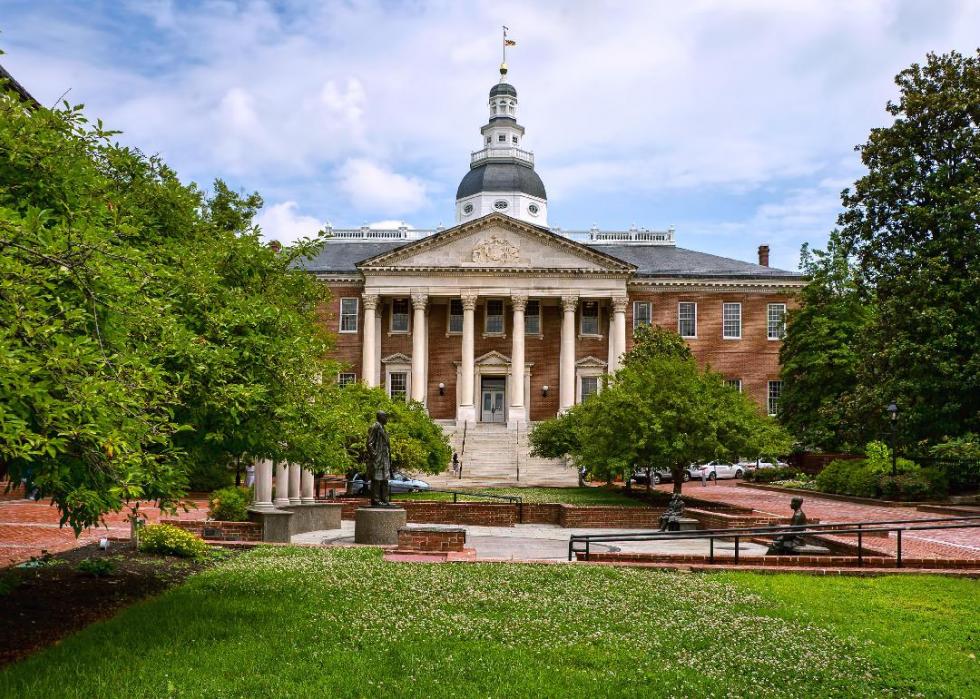
#21. Maryland
- Presidential election outcome between 1964-2016: voted 11 times Democratic (78.6%), 3 times Republican (21.4%)
- Cook Partisan Voter Index: D +12
--- 2016 state popular vote: 60.3% Hillary Clinton, 33.9% Donald Trump
--- 2012 state popular vote: 62% Barack Obama, 35.9% Mitt Romney
- Resident political affiliation: strong Democratic (54% Democrat or lean Democratic, 31% Republican or lean Republican)
- Governor political affiliation: Republican
- Senator political affiliation: 2 Democratic, 0 Republican
- Party in control of state legislature: Democratic
--- State senate: 32 Democratic (68.1%), 14 Republican (29.8%)
--- State house: 99 Democratic (70.2%), 42 Republican (29.8%)
Like its neighbors in the Mid-Atlantic and up through the Northeast, Maryland is reliably blue—it hasn’t voted Republican since George H.W. Bush in 1988. Voter enthusiasm there is currently high. Enough of them turned out on the first day of early voting to break the record, which was set four years ago in 2016.
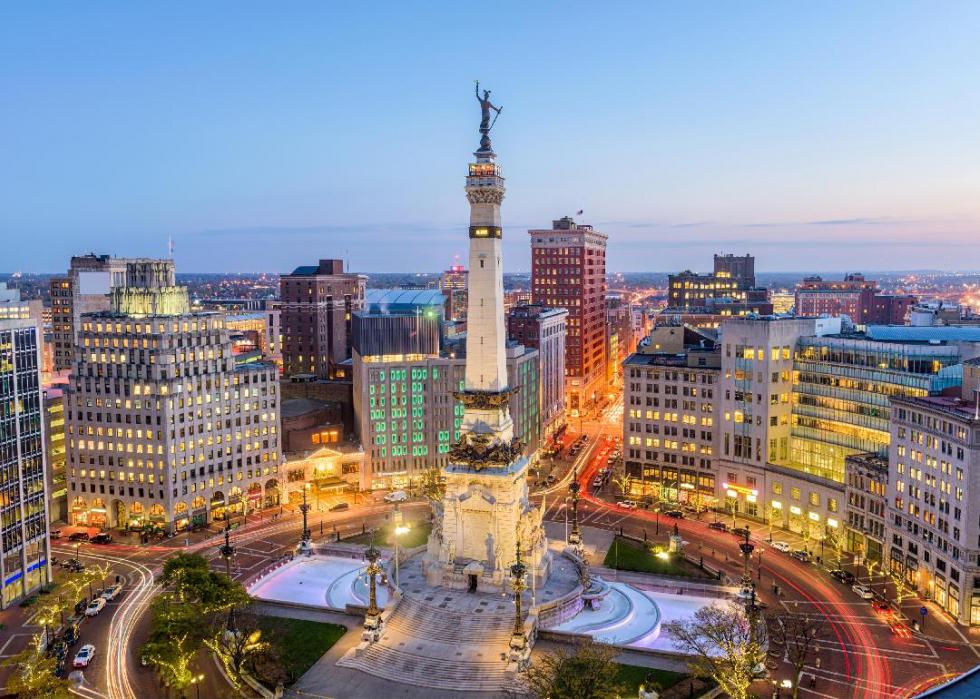
#20. Indiana
- Presidential election outcome between 1964-2016: voted 2 times Democratic (14.3%), 12 times Republican (85.7%)
- Cook Partisan Voter Index: R +9
--- 2016 state popular vote: 37.8% Hillary Clinton, 56.9% Donald Trump
--- 2012 state popular vote: 43.9% Barack Obama, 54.1% Mitt Romney
- Resident political affiliation: lean Republican (38% Democrat or lean Democratic, 46% Republican or lean Republican)
- Governor political affiliation: Republican
- Senator political affiliation: 0 Democratic, 2 Republican
- Party in control of state legislature: Republican
--- State senate: 10 Democratic (20%), 40 Republican (80%)
--- State house: 33 Democratic (33%), 67 Republican (67%)
Despite voting for Barack Obama in 2008, Indiana is a red state that was likely to vote for President Trump even if Vice President Mike Pence weren’t a prominent Hoosier. Prior to 2008, Indiana hadn’t voted for a Democrat since Lyndon Johnson in 1964 and before that, not since Franklin Roosevelt in 1936.
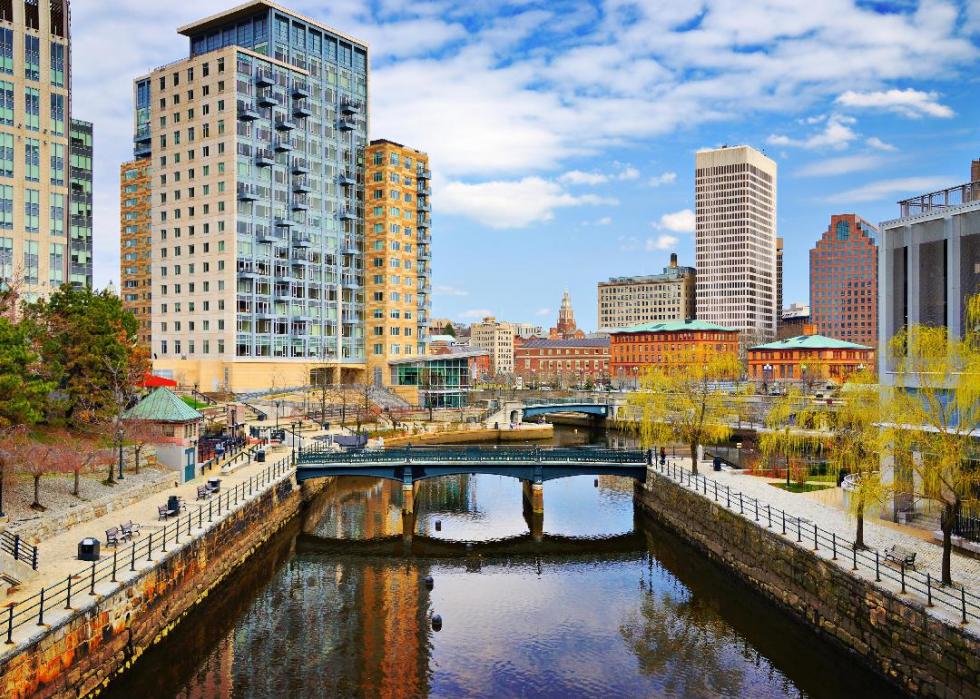
#19. Rhode Island
- Presidential election outcome between 1964-2016: voted 12 times Democratic (85.7%), 2 times Republican (14.3%)
- Cook Partisan Voter Index: D +10
--- 2016 state popular vote: 54.4% Hillary Clinton, 38.9% Donald Trump
--- 2012 state popular vote: 62.7% Barack Obama, 35.2% Mitt Romney
- Resident political affiliation: lean Democratic (43% Democrat or lean Democratic, 36% Republican or lean Republican)
- Governor political affiliation: Democratic
- Senator political affiliation: 2 Democratic, 0 Republican
- Party in control of state legislature: Democratic
--- State senate: 33 Democratic (86.8%), 5 Republican (13.2%)
--- State house: 66 Democratic (88%), 9 Republican (12%)
While many states are grappling with how to handle dramatic increases in early voting and bracing for delayed election results, tiny Rhode Island has worked hard to prevent that kind of chaos. The state Board of Elections voted unanimously to break from practice and release mail-in ballot results as they’re counted instead of waiting until counting is complete.
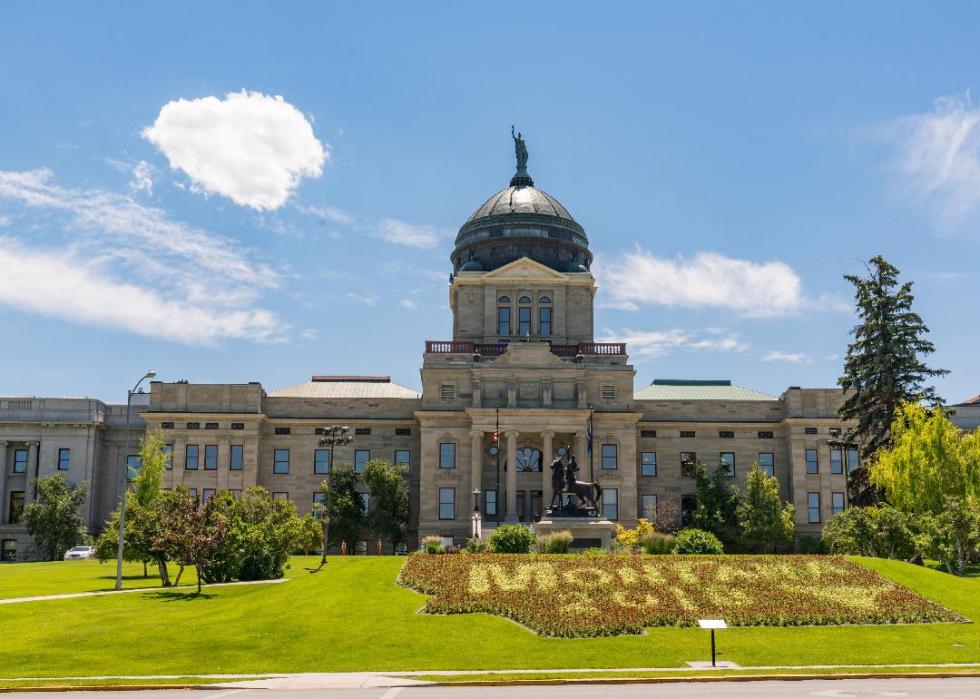
#18. Montana
- Presidential election outcome between 1964-2016: voted 2 times Democratic (14.3%), 12 times Republican (85.7%)
- Cook Partisan Voter Index: R +11
--- 2016 state popular vote: 35.7% Hillary Clinton, 56.2% Donald Trump
--- 2012 state popular vote: 41.7% Barack Obama, 55.4% Mitt Romney
- Resident political affiliation: lean Republican (39% Democrat or lean Democratic, 46% Republican or lean Republican)
- Governor political affiliation: Democratic
- Senator political affiliation: 1 Democratic, 1 Republican
- Party in control of state legislature: Republican
--- State senate: 20 Democratic (40%), 30 Republican (60%)
--- State house: 43 Democratic (43%), 57 Republican (57%)
Voting Democratic only twice since the state went for Dwight Eisenhower in 1952, Montana is all but a shoo-in for Donald Trump in 2020. Down-ballot, however, things get much more interesting. Montanans are currently voting in a competitive Senate race, a competitive House race, and the most competitive governor’s race in America.

#17. Massachusetts
- Presidential election outcome between 1964-2016: voted 12 times Democratic (85.7%), 2 times Republican (14.3%)
- Cook Partisan Voter Index: D +12
--- 2016 state popular vote: 60% Hillary Clinton, 32.8% Donald Trump
--- 2012 state popular vote: 60.7% Barack Obama, 37.5% Mitt Romney
- Resident political affiliation: strong Democratic (56% Democrat or lean Democratic, 27% Republican or lean Republican)
- Governor political affiliation: Republican
- Senator political affiliation: 2 Democratic, 0 Republican
- Party in control of state legislature: Democratic
--- State senate: 36 Democratic (90%), 4 Republican (10%)
--- State house: 127 Democratic (79.4%), 31 Republican (19.4%)
In 2020, Maine will make history as the first state to institute ranked-choice voting (RCV) in the general election—but Massachusetts might not be far behind in joining its New England neighbors to the north. Residents there will vote on the issue in November as a ballot question, and if it passes, Massachusetts residents, too, will be able to numerically rank their choice of candidates.

#16. Hawaii
- Presidential election outcome between 1964-2016: voted 12 times Democratic (85.7%), 2 times Republican (14.3%)
- Cook Partisan Voter Index: D +18
--- 2016 state popular vote: 62.2% Hillary Clinton, 30% Donald Trump
--- 2012 state popular vote: 70.6% Barack Obama, 27.8% Mitt Romney
- Resident political affiliation: strong Democratic (54% Democrat or lean Democratic, 29% Republican or lean Republican)
- Governor political affiliation: Democratic
- Senator political affiliation: 2 Democratic, 0 Republican
- Party in control of state legislature: Democratic
--- State senate: 24 Democratic (96%), 1 Republican (4%)
--- State house: 46 Democratic (90.2%), 5 Republican (9.8%)
As in much of the country, mail-in voting is expanding in Hawaii, but the solidly blue state still suffers from among the lowest voter turnout in America. In the 2018 midterm elections, less than 40% of eligible voters actually voted, a lower percentage than any other state in the nation.
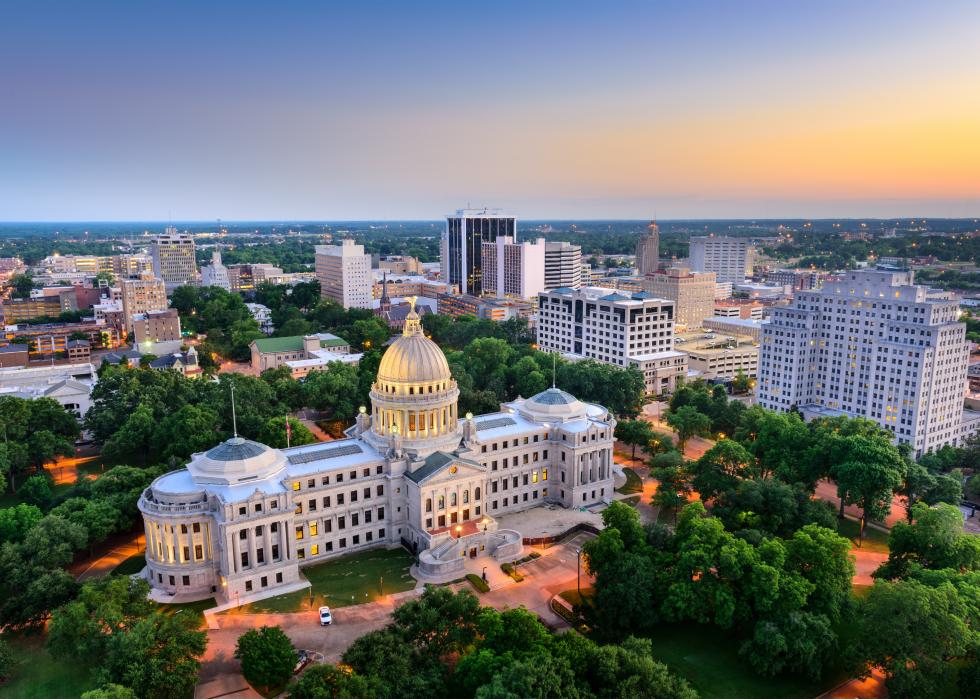
#15. Mississippi
- Presidential election outcome between 1964-2016: voted 1 time Democratic (7.1%), 12 times Republican (85.7%)
- Cook Partisan Voter Index: R +9
--- 2016 state popular vote: 40.1% Hillary Clinton, 57.9% Donald Trump
--- 2012 state popular vote: 43.8% Barack Obama, 55.3% Mitt Romney
- Resident political affiliation: strong Republican (36% Democrat or lean Democratic, 48% Republican or lean Republican)
- Governor political affiliation: Republican
- Senator political affiliation: 0 Democratic, 2 Republican
- Party in control of state legislature: Republican
--- State senate: 16 Democratic (30.8%), 36 Republican (69.2%)
--- State house: 45 Democratic (36.9%), 76 Republican (62.3%)
One of the most conservative states in the country, Mississippi is the heart of red America. The state voted Republican in every election since 1964 except for two: Jimmy Carter in 1976 and George Wallace in 1968. In the runup to the 2020 election, the state expanded access to curbside voting for people experiencing COVID-19 symptoms and created a process to let absentee voters correct minor signature discrepancies on questionable ballots.
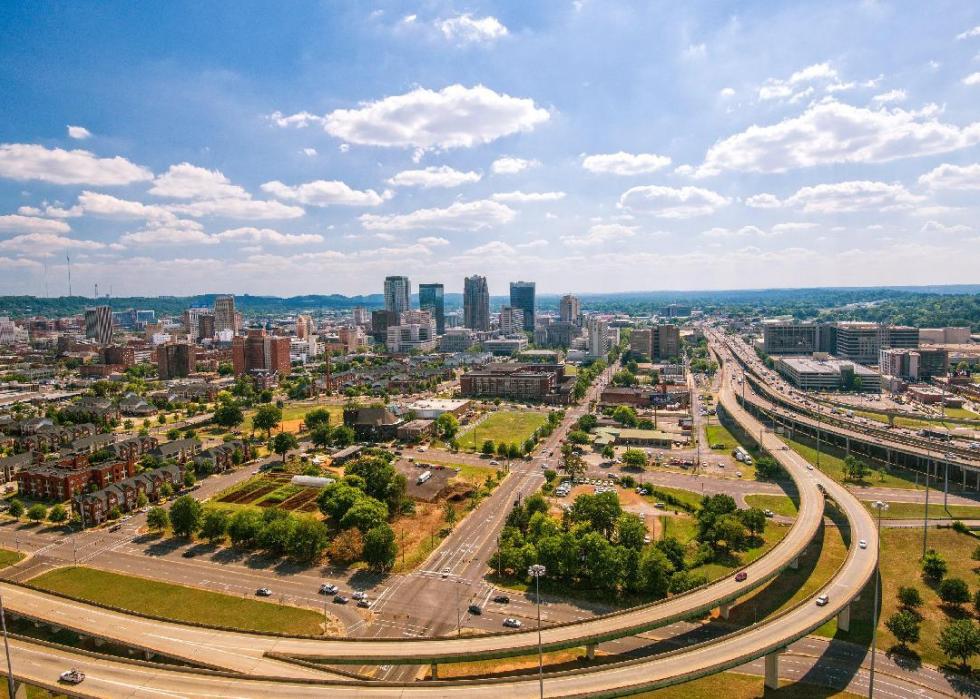
#14. Alabama
- Presidential election outcome between 1964-2016: voted 1 time Democratic (7.1%), 12 times Republican (85.7%)
- Cook Partisan Voter Index: R +14
--- 2016 state popular vote: 34.4% Hillary Clinton, 62.1% Donald Trump
--- 2012 state popular vote: 38.4% Barack Obama, 60.6% Mitt Romney
- Resident political affiliation: strong Republican (35% Democrat or lean Democratic, 52% Republican or lean Republican)
- Governor political affiliation: Republican
- Senator political affiliation: 1 Democratic, 1 Republican
- Party in control of state legislature: Republican
--- State senate: 8 Democratic (22.9%), 27 Republican (77.1%)
--- State house: 28 Democratic (26.7%), 75 Republican (71.4%)
Alabama crushed all previous records when 200,000 residents cast absentee ballots there with three full days still left in early voting. Like its neighbor Mississippi, Alabama has voted Republican in every election cycle since 1964 except for Jimmy Carter and George Wallace.

#13. Minnesota
- Presidential election outcome between 1964-2016: voted 13 times Democratic (92.9%), 1 time Republican (7.1%)
- Cook Partisan Voter Index: D +1
--- 2016 state popular vote: 46.4% Hillary Clinton, 44.9% Donald Trump
--- 2012 state popular vote: 52.7% Barack Obama, 45% Mitt Romney
- Resident political affiliation: lean Democratic (46% Democrat or lean Democratic, 38% Republican or lean Republican)
- Governor political affiliation: Democratic
- Senator political affiliation: 2 Democratic, 0 Republican
- Party in control of state legislature: Divided
--- State senate: 32 Democratic (47.8%), 35 Republican (52.2%)
--- State house: 75 Democratic (56%), 59 Republican (44%)
With the exception of Richard Nixon in 1972, Minnesota voters have chosen the Democratic presidential candidate in every general election for six decades since 1960. Voters there chose the Republican candidate only three times since 1932.
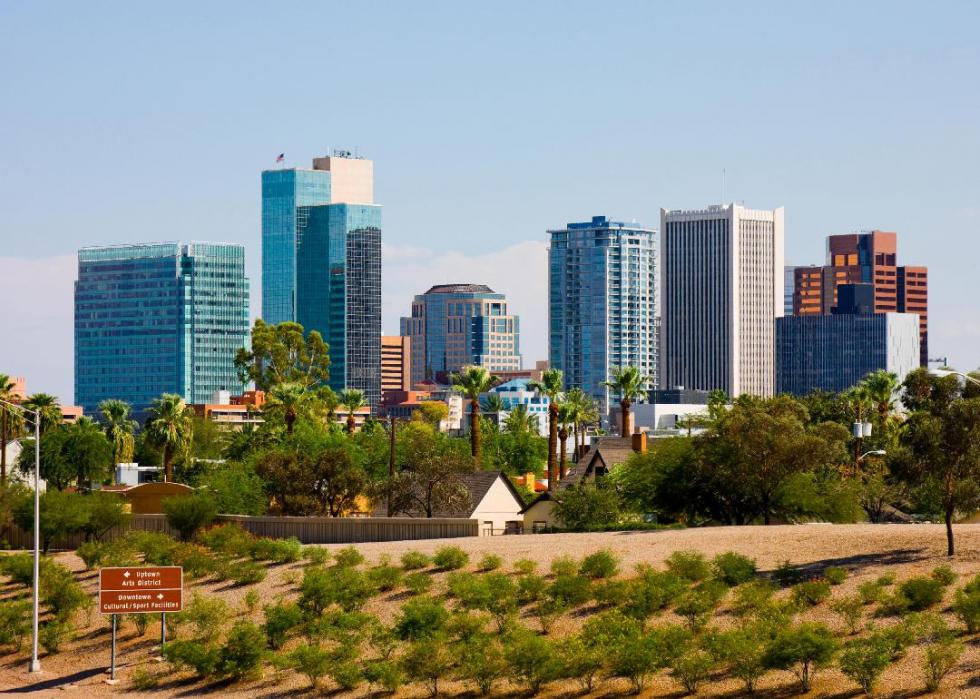
#12. Arizona
- Presidential election outcome between 1964-2016: voted 1 time Democratic (7.1%), 13 times Republican (92.9%)
- Cook Partisan Voter Index: R +5
--- 2016 state popular vote: 45.1% Hillary Clinton, 48.7% Donald Trump
--- 2012 state popular vote: 44.6% Barack Obama, 53.7% Mitt Romney
- Resident political affiliation: competitive (41% Democrat or lean Democratic, 41% Republican or lean Republican)
- Governor political affiliation: Republican
- Senator political affiliation: 1 Democratic, 1 Republican
- Party in control of state legislature: Republican
--- State senate: 13 Democratic (43.3%), 17 Republican (56.7%)
--- State house: 29 Democratic (48.3%), 31 Republican (51.7%)
Arizona would be a huge trophy for the Democrats to snag from the Republicans—with the exception of Bill Clinton in 1996, the state hasn't voted for a Democrat since Harry Truman in 1948. In 2020, however, polls have Biden in the lead. Down ballot, Democratic challenger and former astronaut Mark Kelly is polling well against Republican Martha McSally, who was appointed to the seat when Sen. John McCain died in 2018.
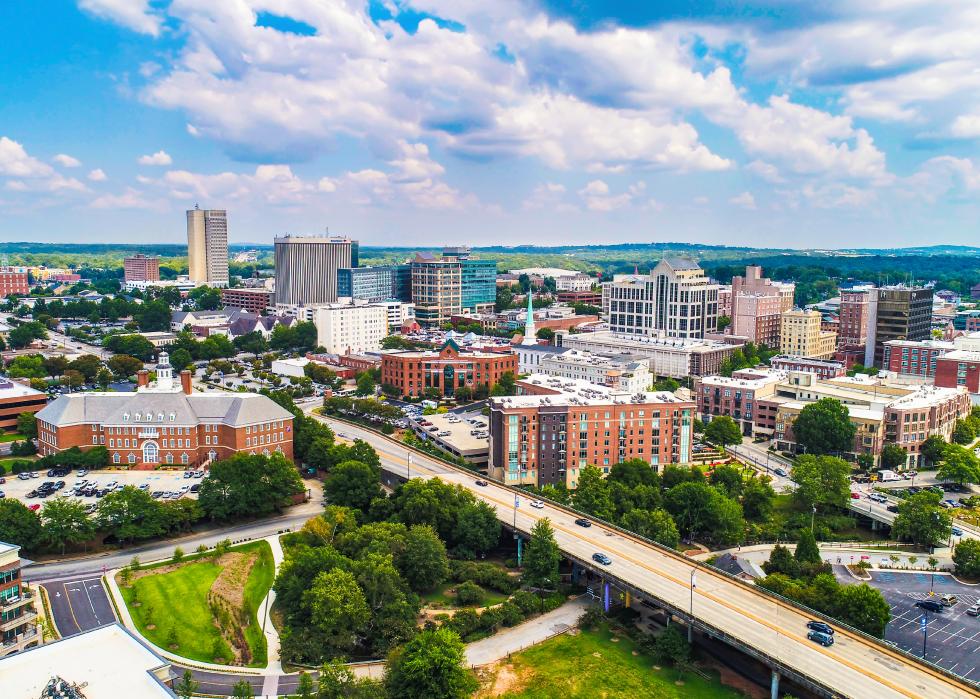
#11. South Carolina
- Presidential election outcome between 1964-2016: voted 1 time Democratic (7.1%), 13 times Republican (92.9%)
- Cook Partisan Voter Index: R +8
--- 2016 state popular vote: 40.7% Hillary Clinton, 54.9% Donald Trump
--- 2012 state popular vote: 44.1% Barack Obama, 54.6% Mitt Romney
- Resident political affiliation: strong Republican (37% Democrat or lean Democratic, 47% Republican or lean Republican)
- Governor political affiliation: Republican
- Senator political affiliation: 0 Democratic, 2 Republican
- Party in control of state legislature: Republican
--- State senate: 19 Democratic (41.3%), 27 Republican (58.7%)
--- State house: 44 Democratic (35.5%), 78 Republican (62.9%)
As it has every time but once for Jimmy Carter in 1976, South Carolina appears poised to cast its nine electoral votes for the Republicans in 2020—but the real drama there is playing out down-ballot. Longtime Republican Sen. Lindsey Graham—a powerful GOP lawmaker and staunch ally of President Trump—is fighting to survive a challenge from Jaime Harrison, a Democratic upstart who has proven to be a talented candidate and formidable fundraiser.

#10. Alaska
- Presidential election outcome between 1964-2016: voted 1 time Democratic (7.1%), 13 times Republican (92.9%)
- Cook Partisan Voter Index: R +9
--- 2016 state popular vote: 36.6% Hillary Clinton, 51.3% Donald Trump
--- 2012 state popular vote: 40.8% Barack Obama, 54.8% Mitt Romney
- Resident political affiliation: strong Republican (33% Democrat or lean Democratic, 51% Republican or lean Republican)
- Governor political affiliation: Republican
- Senator political affiliation: 0 Democratic, 2 Republican
- Party in control of state legislature: Republican
--- State senate: 7 Democratic (35%), 13 Republican (65%)
--- State house: 14 Democratic (35%), 22 Republican (55%)
Democrats are not used to being competitive in Alaska, a state that has gone Republican in every election except for one in its entire 60-year voting history. This year will likely be no different at the top of the ticket. Down-ballot, however, Democratic Senate candidate Al Gross, although behind in the polls, has created a surprisingly close contest against Republican incumbent Dan Sullivan.
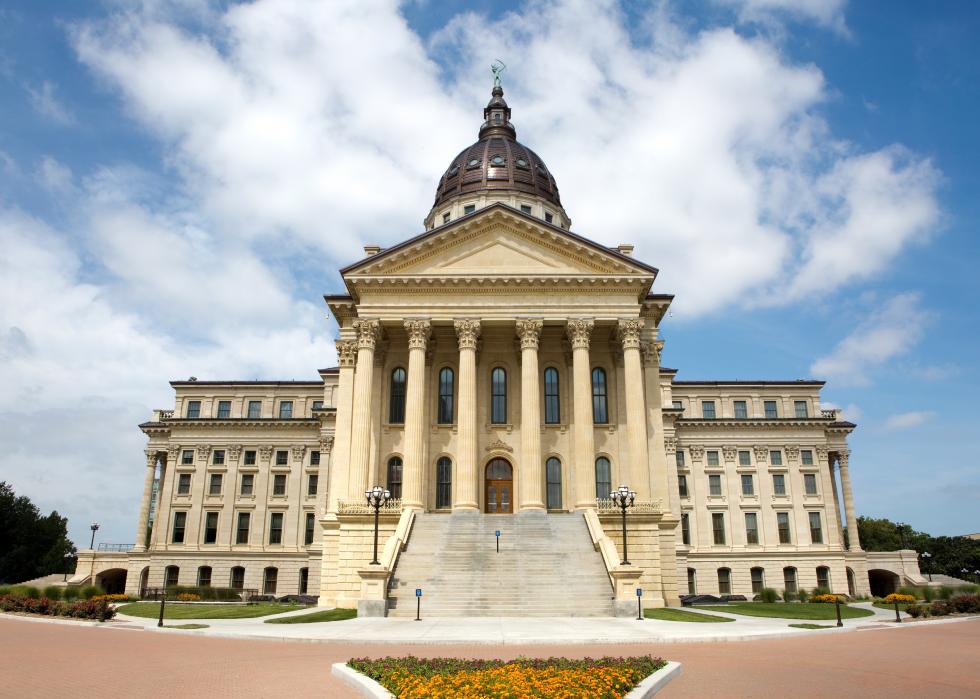
#9. Kansas
- Presidential election outcome between 1964-2016: voted 1 time Democratic (7.1%), 13 times Republican (92.9%)
- Cook Partisan Voter Index: R +13
--- 2016 state popular vote: 36.1% Hillary Clinton, 56.7% Donald Trump
--- 2012 state popular vote: 38% Barack Obama, 59.7% Mitt Romney
- Resident political affiliation: strong Republican (36% Democrat or lean Democratic, 47% Republican or lean Republican)
- Governor political affiliation: Democratic
- Senator political affiliation: 0 Democratic, 2 Republican
- Party in control of state legislature: Republican
--- State senate: 11 Democratic (27.5%), 29 Republican (72.5%)
--- State house: 41 Democratic (32.8%), 84 Republican (67.2%)
Voting Republican in every presidential election since 1968 and all but one since 1940, Kansas is as red as it gets. Today, however, Republicans have been forced to pour money into the state to shore up what was supposed to be a safe seat, but might end up going down as the GOP’s first lost Senate race in Kansas since 1932. State Sen. Barbara Bollier has proven to be a skilled fundraiser in her bid to take an open Senate seat from Republican Roger Marshall.
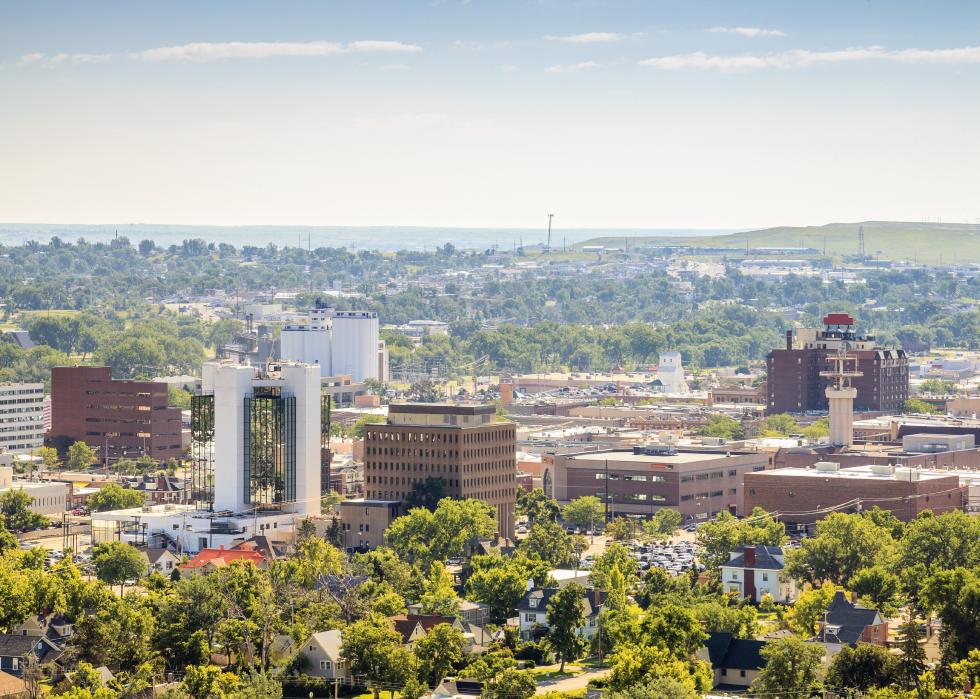
#8. South Dakota
- Presidential election outcome between 1964-2016: voted 1 time Democratic (7.1%), 13 times Republican (92.9%)
- Cook Partisan Voter Index: R +14
--- 2016 state popular vote: 31.7% Hillary Clinton, 61.5% Donald Trump
--- 2012 state popular vote: 39.9% Barack Obama, 57.9% Mitt Romney
- Resident political affiliation: strong Republican (40% Democrat or lean Democratic, 51% Republican or lean Republican)
- Governor political affiliation: Republican
- Senator political affiliation: 0 Democratic, 2 Republican
- Party in control of state legislature: Republican
--- State senate: 5 Democratic (14.3%), 30 Republican (85.7%)
--- State house: 11 Democratic (15.7%), 59 Republican (84.3%)
South Dakota joins Mississippi as one of the most conservative states in America and all but a sure bet for Republican presidential candidates. One of seven states with the minimum three electoral votes, South Dakota last voted Democratic in 1964 and only four times since its voting history began in 1892.
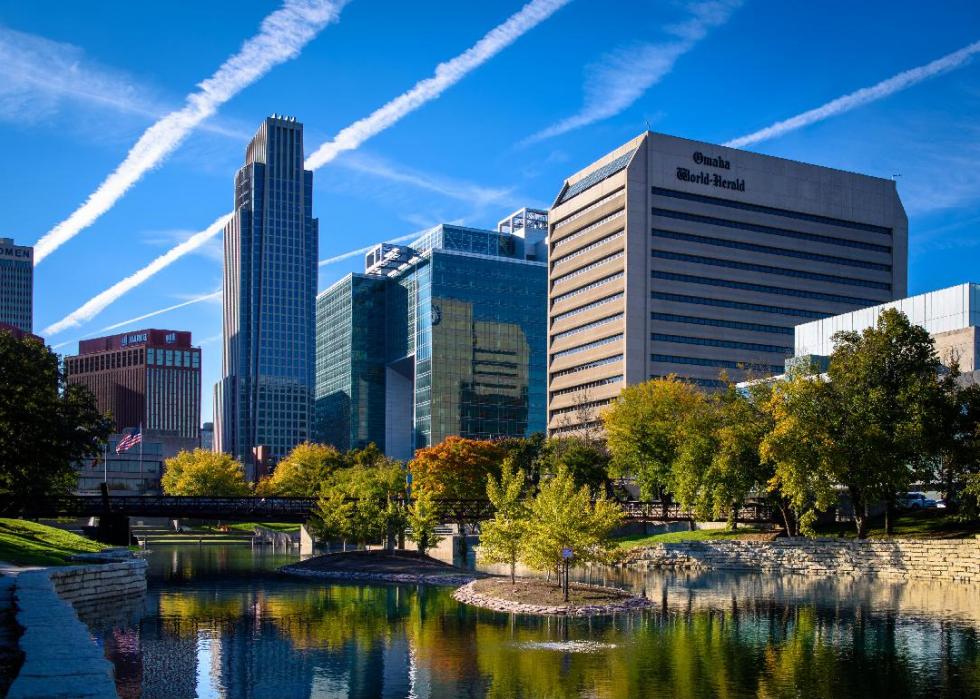
#7. Nebraska
- Presidential election outcome between 1964-2016: voted 1 time Democratic (7.1%), 13 times Republican (92.9%)
- Cook Partisan Voter Index: R +14
--- 2016 state popular vote: 33.7% Hillary Clinton, 58.7% Donald Trump
--- 2012 state popular vote: 38% Barack Obama, 59.8% Mitt Romney
- Resident political affiliation: competitive (42% Democrat or lean Democratic, 43% Republican or lean Republican)
- Governor political affiliation: Republican
- Senator political affiliation: 0 Democratic, 2 Republican
- Party in control of state legislature: Not applicable due to having a nonpartisan, unicameral legislature
Only two states operate outside of a winner-take-all Electoral College system—Maine and Nebraska. Pundits have predicted that a split vote in either or both states could wind up deciding a close election in 2020.
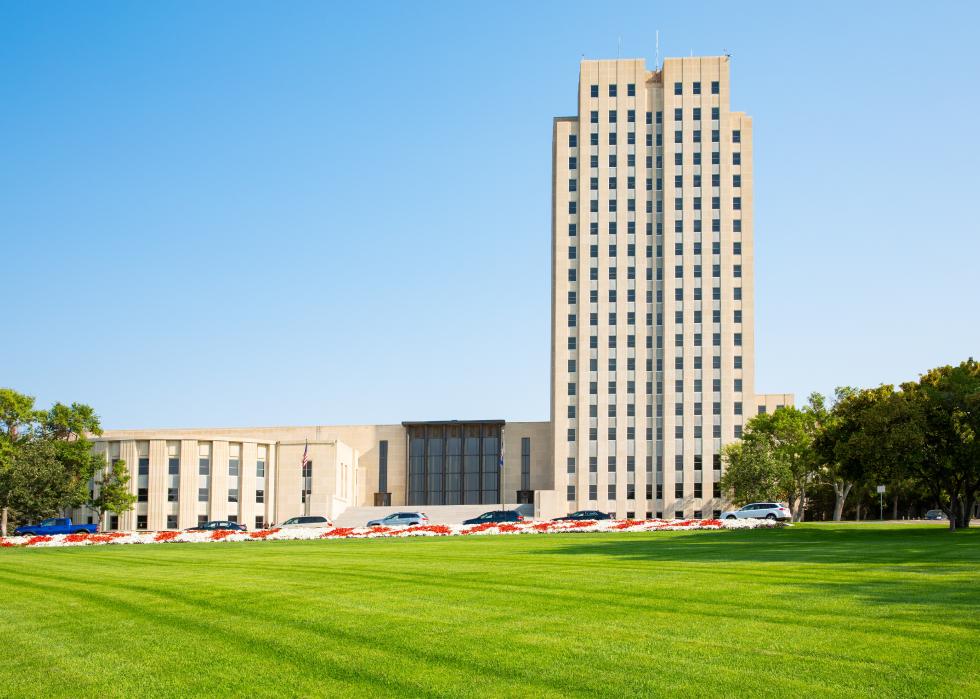
#6. North Dakota
- Presidential election outcome between 1964-2016: voted 1 time Democratic (7.1%), 13 times Republican (92.9%)
- Cook Partisan Voter Index: R +17
--- 2016 state popular vote: 27.2% Hillary Clinton, 63% Donald Trump
--- 2012 state popular vote: 38.7% Barack Obama, 58.3% Mitt Romney
- Resident political affiliation: strong Republican (30% Democrat or lean Democratic, 55% Republican or lean Republican)
- Governor political affiliation: Republican
- Senator political affiliation: 0 Democratic, 2 Republican
- Party in control of state legislature: Republican
--- State senate: 10 Democratic (21.3%), 37 Republican (78.7%)
--- State house: 15 Democratic (16%), 79 Republican (84%)
Voting Democratic only once since 1940, North Dakota is as reliably red as its eponymous neighbor to the south. The GOP-run state recently moved to speed up its election results by allowing officials to process early ballots before Election Day.

#5. Idaho
- Presidential election outcome between 1964-2016: voted 1 time Democratic (7.1%), 13 times Republican (92.9%)
- Cook Partisan Voter Index: R +19
--- 2016 state popular vote: 27.5% Hillary Clinton, 59.3% Donald Trump
--- 2012 state popular vote: 32.6% Barack Obama, 64.5% Mitt Romney
- Resident political affiliation: strong Republican (34% Democrat or lean Democratic, 50% Republican or lean Republican)
- Governor political affiliation: Republican
- Senator political affiliation: 0 Democratic, 2 Republican
- Party in control of state legislature: Republican
--- State senate: 7 Democratic (20%), 28 Republican (80%)
--- State house: 14 Democratic (20%), 56 Republican (80%)
Kicking off the top five is Idaho, which hasn’t voted for a Democrat since Lyndon Johnson in 1964, the only year it broke from the GOP from 1952 to today. Its electorate consistently proved willing to elect Democratic governors as recently as 30 years ago, but it hasn’t done that since 1990.

#4. Utah
- Presidential election outcome between 1964-2016: voted 1 time Democratic (7.1%), 13 times Republican (92.9%)
- Cook Partisan Voter Index: R +20
--- 2016 state popular vote: 27.5% Hillary Clinton, 45.5% Donald Trump
--- 2012 state popular vote: 24.8% Barack Obama, 72.8% Mitt Romney
- Resident political affiliation: strong Republican (28% Democrat or lean Democratic, 56% Republican or lean Republican)
- Governor political affiliation: Republican
- Senator political affiliation: 0 Democratic, 2 Republican
- Party in control of state legislature: Republican
--- State senate: 6 Democratic (20.7%), 23 Republican (79.3%)
--- State house: 16 Democratic (21.3%), 59 Republican (78.7%)
Fiercely conservative Utah roundly rejected Hillary Clinton in 2016, but the state was not nearly as receptive to Donald Trump as it tends to be to Republican presidential candidates—the future president failed to secure a majority of voters there. That’s because Mormon conservative candidate Evan McMullin gobbled up more than 21.5% of the vote by providing an alternative to voters leary of the crude and morally flexible New Yorker. It was the best showing of any third-party candidate in any state since Ross Perot shook up the political world in 1992.

#3. Oklahoma
- Presidential election outcome between 1964-2016: voted 1 time Democratic (7.1%), 13 times Republican (92.9%)
- Cook Partisan Voter Index: R +20
--- 2016 state popular vote: 28.9% Hillary Clinton, 65.3% Donald Trump
--- 2012 state popular vote: 33.2% Barack Obama, 66.8% Mitt Romney
- Resident political affiliation: lean Republican (38% Democrat or lean Democratic, 46% Republican or lean Republican)
- Governor political affiliation: Republican
- Senator political affiliation: 0 Democratic, 2 Republican
- Party in control of state legislature: Republican
--- State senate: 9 Democratic (18.8%), 38 Republican (79.2%)
--- State house: 23 Democratic (22.8%), 77 Republican (76.2%)
Since 1952, Oklahoma voted with the Democrats only once—in 1964 for Lyndon Johnson, although it peeled off one of eight electoral votes for Democrat Robert Byrd the previous cycle. Thanks to a new law that allows just about anyone to buy their way onto the ticket for $35,000, Oklahomans this year will choose between a record six presidential candidates, including Kanye West.

#2. Wyoming
- Presidential election outcome between 1964-2016: voted 1 time Democratic (7.1%), 13 times Republican (92.9%)
- Cook Partisan Voter Index: R +25
--- 2016 state popular vote: 21.9% Hillary Clinton, 68.2% Donald Trump
--- 2012 state popular vote: 27.8% Barack Obama, 68.6% Mitt Romney
- Resident political affiliation: strong Republican (25% Democrat or lean Democratic, 59% Republican or lean Republican)
- Governor political affiliation: Republican
- Senator political affiliation: 0 Democratic, 2 Republican
- Party in control of state legislature: Republican
--- State senate: 3 Democratic (10%), 27 Republican (90%)
--- State house: 9 Democratic (15%), 50 Republican (83.3%)
The least-populous state in America is also among the most conservative, voting with the GOP in every presidential election except for one since 1952. This year, however, pundits and Republican brass alike are bracing for a Libertarian-inspired election shakeup. The state has fostered one of the most Libertarian-friendly climates in America and this year, the alternative party has fielded credible candidates in key races across the state.
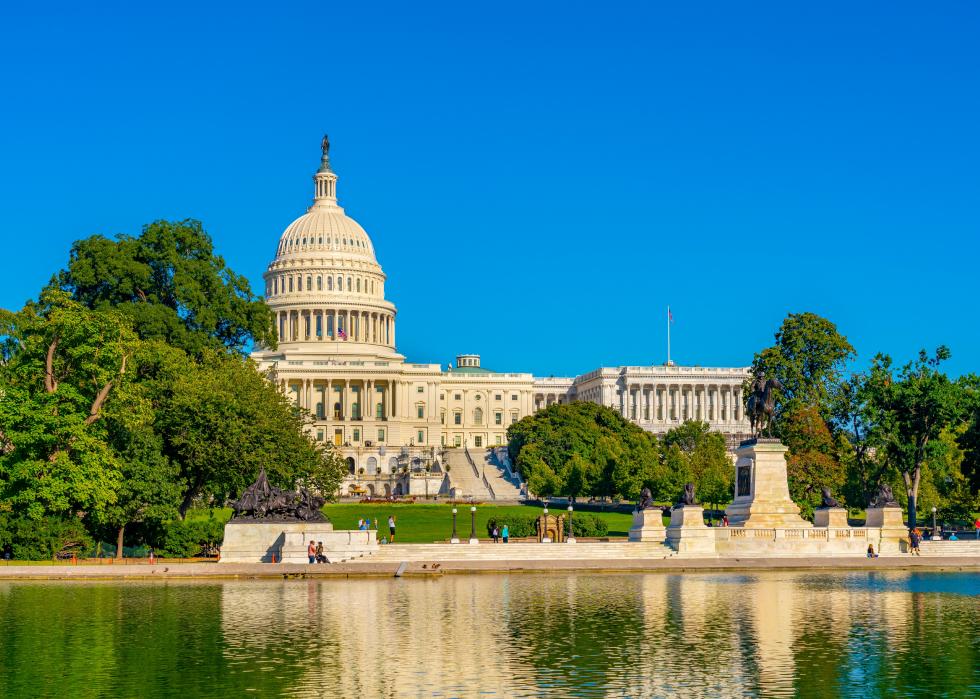
#1. Washington D.C.
- Presidential election outcome between 1964-2016: voted 14 times Democratic (100%), 0 times Republican (0%)
- Cook Partisan Voter Index: D +43
--- 2016 state popular vote: 90.9% Hillary Clinton, 4.1% Donald Trump
--- 2012 state popular vote: 90.9% Barack Obama, 7.3% Mitt Romney
- Governor political affiliation: Democratic (Note: the mayor also serves as D.C.’s governor)
The most politically entrenched state in America isn’t a state at all—at least not yet. The reason that the GOP is so adamantly against statehood for the nation’s capital is that Washington D.C.—whose license plate slogan is “taxation without representation”—would almost certainly deliver two more senators to the Democrats, with whom the District sides by margins not seen anywhere else. The long-simmering D.C. statehood movement has now gained a measurable head of steam and a 51st star on the flag is now a real possibility should Democrats sweep both houses of Congress and the presidency on Election Day.



